

A Trusted Source For Boating Information Since 2019
Catamaran hulls- everything you need to know.
- Post Written By: Boater Jer
- Published: July 17, 2022
- Updated: July 19, 2022

Disclaimer: You might notice that we recommend products in some articles. We may earn a commission for referring you if you click the link and buy a product.
We only recommend products we’ve tried/tested/own (that’s why you won’t find thousands of affiliate links on my site). If you have experience with one of the products we’ve mentioned, please share your experiences in the comments at the end.
Advertisement

Catamaran hulls are not like normal boats but provide increased stability. Let’s take a look at these incredible boats and how their hulls create one of the most versatile watercraft available today.
The Tamil Cholas used catamarans to ferry their troops to invade Malaysia, Indonesia, and Burma. The early paravars or fishing communities in the southern part of Tamil Nadu used two-hulled boats to fish. Polynesian seafarers were also early users of the catamaran, utilizing the watercraft to get to hard-to-reach islands. ( source )
Although the catamaran hull concept is a relatively new introduction to modern boat design , the boat has been in use since the 5th century. It was used for fishing, traveling, and transporting people and supplies.
Parts Of A Catamaran
Here are the basic parts of the modern sailing catamaran:
- Hulls are what sets this boat apart from the rest. The catamaran has two hulls, while the monohull, as the name suggests, has only one hull. Most of the advantages of this boat are hinged on these two hulls.
- The bridge deck connects the two catamaran hulls.
- On top of the catamaran hulls and the bridge deck is the deck . It is where owners attach most of the equipment in a boat.
- You can locate the berth, the galley, and other living amenities in the cabin .
- The cockpit is where you find the navigation equipment of the boat . It is where you control the catamaran’s rudder, sails, and engine.
Types Of Catamaran
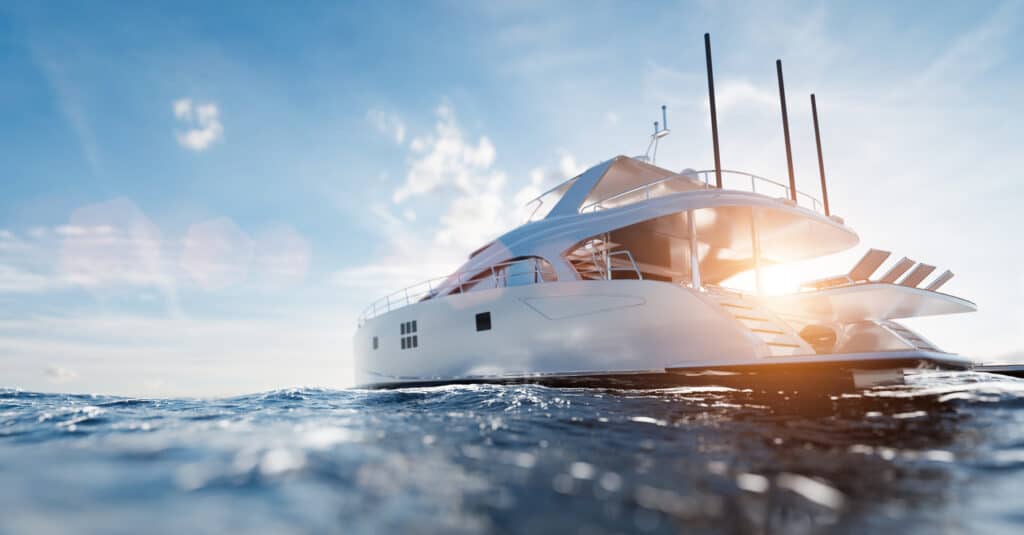
The modern catamaran is far more different than its crude ancestor. Instead of tree cutouts, catamarans are now carbon fiber or fiberglass. Here are the different types of catamarans:

Based On function
Pontoons are usually present on rivers and lakes and sometimes even on oceans, but they only travel near the shore.
In a catamaran pontoon-type boat, the pontoons serve as storage areas, where you will find the onboard motors. They are useful for water leisure activities such as short water trips, tubing, wakeboarding, and water skiing.
Some pontoons may also serve as houseboats. They provide a broader, more stable platform ideal for a floating house. Plus, the space is bigger, and most of it is above water. It offers a better viewing option than a monohull. ( Source )
Small Waterplane Area Twin Hull is a catamaran-type boat that the United States Navy initially used for military purposes. They provide the water stability that is necessary when transporting heavy military equipment.
One example of a military SWATH catamaran is the Spearhead class EPF. It is as long as a World War II escort destroyer, yet it is twice as fast at 43 knots. It can reach that speed because of its two separate hulls.
Because of their innate speed, SWATH catamarans can become patrol boats in lakes and rivers. They can easily outrun and outmaneuver standard watercraft.
Nowadays, there are SWATH cruise ships and other non-military variations. ( Source )

Based On Design
- Sailing Catamaran
The smaller sailing catamarans do not have auxiliary engines, so the owner can propel the boat by harnessing the wind using the sails. It’s a popular choice for people with very little or no sailing experience because they are light and easy to use.
The larger sailing catamarans are for group charters and long-distance cruising. They have become so popular lately that they now outnumber monohulls in tropical locations all over the world. They have a last, a headsail, and a mainsail. And the twin hulls have one engine each.
- Power Catamaran
Unlike their sailing cousins, the powered catamarans do not have sails. They have massive engines which provide high speed. Their twin hulls are stronger and can carry and protect the large motors.
The smaller “powercats” are used mainly for fishing. The bigger ones are rented out for charters and cruises.
Catamaran Hulls Performance
Thanks to the catamaran hulls, the boat offers many advantages over other boat types.
- Because its dual-hull design provides a broader base, it offers more water stability than monohull boats. It makes the cat (catamaran) a popular choice for fishing expeditions and cruises.
- Riding a catamaran is ideal for people who feel seasick whenever they ride boats. The twin hulls prevent the boat from moving from side to side. The hulls allow the boat to travel smoothly, even on moderately choppy waters.
- The catamaran is the best choice when storing provisions and other household items with less heeling and bobbing.
- The twin hulls’ stability is ideal for many activities such as cooking and partying.
- Cats offer more moving space because of their broader base, thanks to dual hulls.
- With a catamaran, you have two great options on where to hang out. You can do it on the spacious deck or below the galley.
- Compared to a monohull of the same size, the catamaran can accommodate more equipment and people.
- The living area in a catamaran is above the water line. This feature provides more natural light, a greater view of the outside, and better air circulation.
- Since catamarans do not have keels, they can anchor on shallow waters, something that most monohulls will not be able to do. This ability of catamaran boats is impressive, especially if you are going around areas with many reefs and small islands.
- Catamaran hulls allow the boat to cut through the waves easier and faster. It means they require less engine power than their monohull counterparts.
- Because it has two engines and two rudders, the catamaran can easily maneuver in very tight spaces.
- Because they do not carry heavy keels, catamarans can sail faster than monohulls.
- The catamaran’s stability, speed, and weight make it a safer option than the monohull. It can sail in shallow waters, make a 360 degrees maneuver effortlessly, and carry more provisions.
Disadvantages Of A Catamaran
Like any other boat type, the catamaran also has drawbacks and limitations. Here are some of them:
- The catamaran hulls prevent the boat from sailing as fast as the monohull upwind. The two hulls cause drag, and this slows the boat considerably.
- Because of its bigger size, looking for a docking site can be more difficult and costlier than a monohull.
- For hardcore sailing fans, the experience of sailing with a catamaran will never be able to match that of sailing with a monohull. To them, the challenge of true sailing is just not there with a catamaran.
What Are The Hulls Of The Catamaran Called?
According to the Online Etymology Dictionary, the Tamil word கட்டுமரம், which is pronounced as kattumaran, is where the word catamaran takes its name. The word means “pieces of logs tied together”. Through the years, the term has evolved into what is now a catamaran in English.

What Are The Characteristics Of A Catamaran Hull?
- Both hulls of a catamaran complement each other to achieve very minimum water resistance.
- Because of this, it takes less energy to propel a catamaran, whether via an engine or sails.
- The catamaran hulls provide stability to the boat. The twin-hull significantly reduces bobbing.
- The catamaran’s ability to keep steady on the water makes it an ideal vessel for cooking, dining, and storing provisions.
Are Catamarans Good In Rough Water?
Catamarans are amazingly stable in rough water. The catamaran’s design and build, which provides stability, are factors why it is one of the best boats to use when the waters are choppy.
Yes, catamarans are relatively more expensive than monohulls. Nevertheless, since single-hull boats are less expensive, their resale value is also cheap.
If you add all the advantages that a catamaran offers – safety, comfort, and speed- it does not come out expensive.
patekphilippe.io

Share this post with your friends
Subscribe to our newsletter.
Join us in our love for all things water. And Adventure.

Can You Kayak In Rough Waters?
Advertisement Kayaking can be leisurely paddling through flat and still waters with great weather conditions and an easy route. However, kayaking can also be paddling through strong winds, strong currents, and choppy waves. Water and weather conditions can change fast, and kayakers must be ready for more challenging conditions. Kayaking in rough waters is common. The majority of kayaks are

Upgrade Your Boating Experience: Adding a Third Pontoon Made Easy!
Advertisement As the sun sets over the tranquil waters, the gentle hum of the engine and the soft lapping of waves against the hull create a symphony of serenity. Boating enthusiasts know there’s nothing like being out on the water, surrounded by nature’s beauty. But what if we told you you could take your boating

How Canoes Are Made (1 Canoe Fabrication Easy Explanation Coming Up!)
Advertisement Want to know how canoes are made? You’ve come to the best place to find out. Canoe fabrication occurs using an incredible variety of materials. Some are made of wood, while others are plastic, and some metals like aluminum. Each material has its benefits. Some are lighter, some are more durable, and others are

A Wizard of Technology – The PowerEgg X Wizard Waterproof Drone
The PowerVision PowerEgg X Wizard Drone – A Waterproof, water-landing aerial drone of the future, today. This thing is just plain awesome.

How To Clean A Kayak
Advertisement Kayaks fabrication uses several different materials that react differently to the water. These materials also respond differently to the conditions of the kayak storage. Kayaks are, in most cases, only used seasonally, which means they spend a significant time stored out of sight and out of mind. The biggest challenge to cleaning a kayak

How Long Does It Take A Canoe To Go… (Canoe Calculator Here)
Advertisement You asked, and we answered: Here’s a calculator to determine how long your canoe trip will take. The calculator uses the average speed of an average canoe in calm water. Here it is: The Canoe Trip Time Calculator: Canoe Trip Calculator Enter the distance: Kilometers Miles Calculate Advertisement Canoe Articles & Information replica rolex

Boat Information By Type
© 2023 Boating.Guide, A Hyperwave Media Group Ltd. Publication.
Privacy Overview
Did You Know That We Offer Contract to Closing Services? Click Here to Find Out More.
Need Marine Financing? Apply Here With Our Partner, First Approval Source
- Catamaran Interviews
- Catamaran Reviews
- Buying Advice
- Selling Advice
- Woods Design Advice
- Americat 3014
- Balance 526
- Bali 40 Catspace
- Beneteau Blue II
- Broadblue 346
- Broadblue 38 Prestige
- Broadblue 385
- Broadblue 435
- Broadblue 46
- Catalac 10M
- Catalac 11M
- Catalac 12M
- Catalac 900
- Catana 42 S
- Chris White 48 Voyager
- Chris White 55
- Corsair F28 R
- De Villiers
- Dolphin 460
- Endeavour 30
- Endeavour 35 Victory
- Endeavour 36
- Endeavour 44
- Endeavour 44 TrawlerCat
- Fortuna 36 Island Spirit
- Fortuna 401 Island Spirit
- FP 32 Maldives
- FP 35 Tobago
- FP 37 Antigua
- FP 38 Athena
- FP 39 Fidji
- FP 40 Lavezzi
- FP 40 Lucia
- FP 40 Summerland MY
- FP 41 Lipari
- FP 42 Astrea
- FP 42 Venezia
- FP 43 Belize
- FP 44 Helia
- FP 44 Orana
- FP 46 Bahia
- FP 46 Casamance
- FP 48 Salina
- FP 56 Marquises
- FP 57 Sanya
- FP 60 Eleuthera
- FP Saona 47
- Gemini 3000
- Gemini 3200
- Gemini 3400
- Grainger 420 Mystery Cove
- Hirondelle 7M
- Lagoon 37 TPI
- Lagoon 42 TPI
- Lagoon 43 PC
- Leopard 39 PowerCat
- Leopard 45 Classic
- Leopard 47 PowerCat
- Leopard 51 PowerCat
- Leopard 53 PowerCat
- Maine Cat 30
- Maine Cat 41
- Matrix 450 Vision
- Matrix 760 Silhouette
- Maverick 400
- Maverick 420
- Maverick 440
- Nautitech 40
- Nautitech 442
- Nautitech 46 Open
- Nautitech 47
- Outremer 40
- Outremer 45
- Outremer 50 Standard
- Outremer 55
- Privilege 37
- Privilege 39
- Privilege 42
- Privilege 43
- Privilege 435
- Privilege 45
- Privilege 465
- Privilege 48 Transcat
- Privilege 482
- Privilege Serie 5
- Prout 31 Quest
- Prout 33 Quest
- Prout 34 Event
- Prout 35 Snowgoose
- Prout 37 Snowgoose
- Prout 37 Snowgoose Elite
- Prout 38 Manta
- Prout 39 Escale
- Royal Cape 45
- Royal Cape 530 Majestic
- Royal Cape Majestic 500
- Sailcraft 30 Iroquois
- Sailcraft 32 Comanche
- Sailcraft 35 Cherokee
- Sailcraft 41 Apache
- Sailcraft 44 Apache
- Wildcat 350
- Seawind 1000
- Seawind 1160
- Seawind 1200
- Seawind 1260
- Seawind 1600
- Solaris 36 Sunrise
- Solaris 36 Sunstar
- St Francis 44
- St Francis 48
- St Francis 50
- Stealth 11.8
- Heavenly Twins 26
- Ocean Twins 38
- Voyage 380 Maxim
- Voyage 400 Norseman
- Voyage 430 Norseman
- Voyage 450 Cabriolet
- Voyage 47 Mayotte
- Wharram 38 Tiki
- AMI 320 Renaissance
- Woods 22 Wizard
- Woods 35 Banshee
- Woods 35 Flica
- Woods 36 Scylla
- Woods 36 Vardo
- Woods 38 Transit
- Woods 40 Meander
- Xquisite X5
- Xquisite X5+
Catamaran Design Formulas
- Post author By Rick
- Post date June 29, 2010
- 10 Comments on Catamaran Design Formulas

Part 2: W ith permission from Terho Halme – Naval Architect
While Part 1 showcased design comments from Richard Woods , this second webpage on catamaran design is from a paper on “How to dimension a sailing catamaran”, written by the Finnish boat designer, Terho Halme. I found his paper easy to follow and all the Catamaran hull design equations were in one place. Terho was kind enough to grant permission to reproduce his work here.
Below are basic equations and parameters of catamaran design, courtesy of Terho Halme. There are also a few references from ISO boat standards. The first step of catamaran design is to decide the length of the boat and her purpose. Then we’ll try to optimize other dimensions, to give her decent performance. All dimensions on this page are metric, linear dimensions are in meters (m), areas are in square meters (m2), displacement volumes in cubic meters (m3), masses (displacement, weight) are in kilograms (kg), forces in Newton’s (N), powers in kilowatts (kW) and speeds in knots.
Please see our catamarans for sale by owner page if you are looking for great deals on affordable catamarans sold directly by their owners.
Length, Draft and Beam
There are two major dimensions of a boat hull: The length of the hull L H and length of waterline L WL . The following consist of arbitrary values to illustrate a calculated example.
L H = 12.20 L WL = 12.00

After deciding how big a boat we want we next enter the length/beam ratio of each hull, L BR . Heavy boats have low value and light racers high value. L BR below “8” leads to increased wave making and this should be avoided. Lower values increase loading capacity. Normal L BR for a cruiser is somewhere between 9 and 12. L BR has a definitive effect on boat displacement estimate.
- Tags Buying Advice , Catamaran Designers

Owner of a Catalac 8M and Catamaransite webmaster.
10 replies on “Catamaran Design Formulas”
Im working though these formuals to help in the conversion of a cat from diesel to electric. Range, Speed, effect of extra weight on the boat….. Im having a bit of trouble with the B_TR. First off what is it? You don’t call it out as to what it is anywhere that i could find. Second its listed as B TR = B WL / T c but then directly after that you have T c = B WL / B TR. these two equasion are circular….
Yes, I noted the same thing. I guess that TR means resistance.
I am new here and very intetested to continue the discussion! I believe that TR had to be looked at as in Btr (small letter = underscore). B = beam, t= draft and r (I believe) = ratio! As in Lbr, here it is Btr = Beam to draft ratio! This goes along with the further elaboration on the subject! Let me know if I am wrong! Regards PETER
I posted the author’s contact info. You have to contact him as he’s not going to answer here. – Rick
Thank you these formulas as I am planning a catamaran hull/ house boat. The planned length will be about thirty six ft. In length. This will help me in this new venture.
You have to ask the author. His link was above. https://www.facebook.com/terho.halme
I understood everything, accept nothing makes sense from Cm=Am/Tc*Bwl. Almost all equations from here on after is basically the answer to the dividend being divided into itself, which gives a constant answer of “1”. What am I missing? I contacted the original author on Facebook, but due to Facebook regulations, he’s bound never to receive it.
Hi Brian, B WL is the maximum hull breadth at the waterline and Tc is the maximum draft.
The equation B TW = B WL/Tc can be rearranged by multiplying both sides of the equation by Tc:
B TW * Tc = Tc * B WL / Tc
On the right hand side the Tc on the top is divided by the Tc on the bottom so the equal 1 and can both be crossed out.
Then divide both sides by B TW:
Cross out that B TW when it is on the top and the bottom and you get the new equation:
Tc = B WL/ B TW
Thank you all for this very useful article
Parfait j aimerais participer à une formation en ligne (perfect I would like to participate in an online training)
Leave a Reply Cancel reply
Your email address will not be published. Required fields are marked *
Save my name, email, and website in this browser for the next time I comment.

Professional BoatBuilder Magazine
An aluminum expedition catamaran.
By Dieter Loibner , Apr 5, 2022
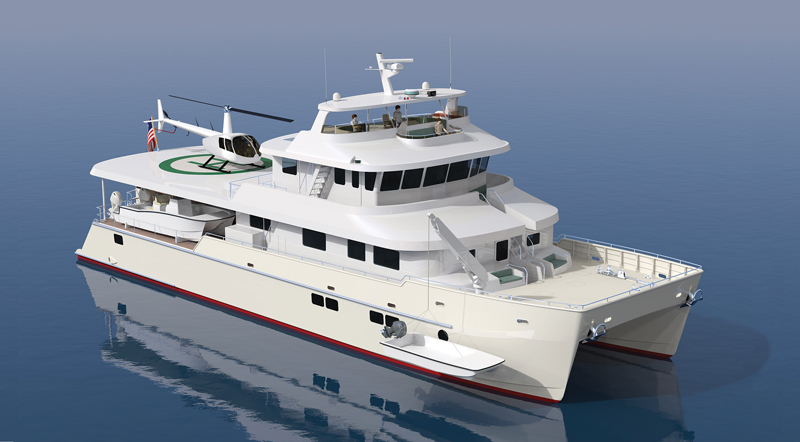
With 110′ LOA, a 35′ beam, and 45′ (33.5m, 10.6m, and 13.7m) of bridge clearance, the H-2 catamaran seeks to make a case for U.S. custom boatbuilding.
Hauling toys beyond the horizon is the raison d’être for a rugged go-anywhere catamaran designed and built in the U.S., a notable exception in the world of big yacht projects.
Gunboat might have left town, but there’s another big catamaran under construction in its old facility in Wanchese, North Carolina. It’s called H-2 , short for Hippocampus 2 , a stout 110-footer (33.5m) that liberally and intentionally quotes from the expedition/workboat vernacular. It’s built from aluminum and was conceived to go to the back of the beyond, where adventure beckons and Vessel Assist doesn’t operate. Aside from commodious and cushy accommodations, the boat offers grid autonomy, ocean-crossing range, and cargo capacity to match the mission of hauling a 26 ‘ (7.92m) tender, a 17 ‘ (5.8m) skiff, a two-person submarine, a four-seat ATV on the main deck, and a small helicopter on the flight deck aft.
The boat was commissioned by Brian Schmitt, 67, a real estate executive in the Florida Keys, who pilots his own plane to commute to the Bahamas, where he keeps Hippocampus , his current 57 ‘ (17.37m) cold-molded wood/epoxy catamaran. I asked him about the jump from 57 ‘ to 110 ‘ . “I never thought I’d have the ability to do that in my own boat until probably the last few years,” he replied, adding that “it would be 120 ‘ [36.58m] if I had to do it today.”
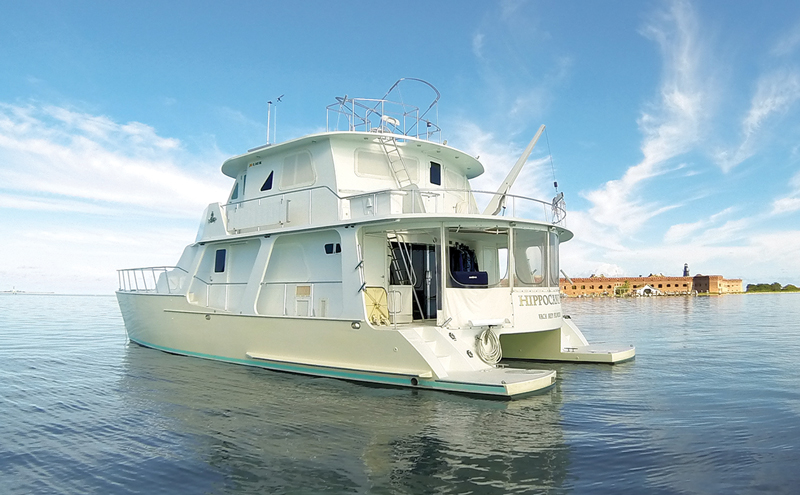
Its predecessor, Hippocampus, built in wood/epoxy, was launched in 2003. At 57′ (17.37m), it is about half as long as H-2, but with 22,500 miles under its keels, it was a useful starting point for designing the new vessel.
Wearing shorts and a shirt with the new boat’s name and logo to our meeting, Schmitt talked openly about his project, which he manages as attentively as his real estate brokerage with 130 agents. Communication is his thing, responding to e-mail questions in near real time (in ALL CAPS) and talking to contractors directly. No project manager.
A passionate diver who habitually explores remote and exotic locales, Schmitt said he was happy with the first Hippocampus , which has three staterooms and cruises at 15 knots on twin 370-hp Yanmars. “It was the vehicle that got our 17 ‘ tender wherever we needed it.” But running the little boat 60 or 70 miles a day lost its charm. “One of the things I wanted was a twin-engine tender that would have more room for dive gear. That ended up being a 26 ‘ Calcutta, so I needed a bigger mother ship.”
With accelerating climate change, the carbon footprint of ships and large yachts is under scrutiny, but hydrocarbons still win when speed, range, and payloads are priorities. While H-2 doesn’t break the mold there, Schmitt pointed to the project’s virtues as a U.S. domestic build. “You can’t complain about global warming when you’re flying around in your G500 jet that’s contributing more CO2 emissions than anybody else in the world,” he said. “You can’t complain about all the boats being built in Germany, The Netherlands, and Italy, and then go buy a boat [there].” Schmidt wanted to build locally, keeping jobs and money in the U.S. Besides, he noted, this approach simplified communications and enabled him to personally check on progress during COVID. Perhaps most importantly, he could pick a team of trusted and compatible mates to turn his dream into a boat.

The vast build hall left vacant when Gunboat left Wanchese, North Carolina.
He selected John Marples, a fellow pilot, inventor, and multihull specialist for the design and Felix Herrin to build H-2 . Both men had worked for him on Hippocampus , and their familiarity helped when meeting today’s challenges, such as damaging trade tariffs that drove up aluminum prices, and a pandemic that killed millions, wreaked havoc on global supply chains, and caused labor shortages in industrial sectors. These factors have conspired to delay H-2 ’s launching by roughly two years and counting.
Advantage Aluminum
A key decision early on was to build in aluminum, which promised a robust structure but required extra steps to deal with corrosion and noise mitigation. “Construction was reduced to something simple—a V-bottom deadrise model, stretched out,” Marples explained. “There wasn’t any benefit to round bilges on an aluminum boat. You’d have to add internal structure to support the flat panels, and it drives the cost and difficulty of construction way up. We’re talking about a speed-to-length ratio of 2 or less, which is not a big deal. His current boat would do a speed/length of about 3, so the extra length means that you’re never really pushing the boat that hard, so shape was not a huge consideration.”
Marples and Herrin go back at least three decades to their mutual acquaintance with naval architect and boatbuilder Dave Dana, who assisted Marples with the hull design for Admiral Pete , a catamaran passenger ferry still serving Puget Sound. Herrin works with different construction materials, but having built crew boats for Petróleos de Venezuela (PDVSA) at Sea Force in Palmetto, Florida, he has spent considerable time with aluminum.

Taking a break during IBEX 2021 are builder Felix Herrin (left) and owner Brian Schmitt. H-2 is their second joint project with designer John Marples.
The structural components on H-2 are 5083-H32 alloy aluminum plate and extrusions of 6061-T6 alloy. Scantlings, materials, and weldment comply with the American Bureau of Shipping’s (ABS) 2016 design guidelines for pleasure motoryachts. Hulls and wing structures have transverse frames and bulkheads spaced on 36 “ (0.91m) centers. Those frames are supported by substantial centerline vertical keels (CVKs) welded atop twin 3 “ x 8 “ (76mm x 203mm) solid extruded-aluminum-bar keels. Intermediate subframes in the forward and aftermost hull compartments strengthen the hulls for operating in ice. Schmitt indicated he wants to traverse the Northwest Passage. For the same reason, there’s 3⁄8 “ (10mm) plate running the length of the boat above and below the waterline.
The topside and underwing plating is primarily ¼ “ (6mm), with areas of 5⁄16 “ (8mm) to strengthen slamming zones in the bow. The main deck plating is also 1/4 “ while the foredeck plate is specified at 5⁄16 “ . The bottom plating is 5⁄16 “ in the aft two-thirds of the hull and 3⁄8 “ forward. “We built all the frames and bulkheads first, then scarfed together the keel sections [and] lined those up on the bunks that we built on,” Herrin explained. “We welded the CVK on top of the keel, then started installing frames.”

Hulls and wing structure have transverse frames and bulkheads on 36″ (0.91m) centers. The hulls are supported by centerline vertical keels.
Herrin said he changed aluminum suppliers midway through the project, sourcing from Bayou Metal Supply , an ISO 9001:2015–certified distributor in Slidell, Louisiana. “We sourced the material from Greece and from domestic suppliers,” said Taylor Smith, who handles Bayou’s sales. Tariffs, he said, did not slow down business much, but the aluminum cost more. “Felix sent cut files. We had the material in inventory, we cut it, processed it on a router, and shipped it on time. Everything flowed well.”
Naval and structural engineering and detailing was contracted out to Van Gorkom Yacht Design in Portsmouth, Rhode Island. “My first responsibility was looking at structures,” Geoff Van Gorkom said. “Given that this is an aluminum yacht, we can do literally all the structures in 3D and have all the metalwork precut before it came into the yard. All the frames and longitudinals and all the primary structure were precut, which saved huge amounts of time.” Van Gorkom said he uses Rhino 3D and some of the numerous modules such as Orca 3D for hydrostatics and hydrodynamics, and 2D AutoCAD to produce construction details.

Helping save time and money, 3D-modeling allowed frames, longitudinals, and the primary structure to be cut before being sent to the building site.
Van Gorkom observed that H-2 is not a fussy high-performance vessel that needs minimum weight to achieve maximum speed. Besides ABS guidelines that address torsional loads in catamaran structures, he also consulted A.L. Dinsenbacher’s paper “A Method for Estimating Loads on Catamaran Cross-Structure” ( Marine Technology , Vol. 7, No. 4, October 1970) to estimate load conditions in beam and quartering seas. “This is going to be a very stiff boat. It’s going to be a very strong boat simply because it has to be, and that was one of the criteria that Brian put out there right from the very start of the project. The boat is sturdy and stout, a strong expedition yacht.”
Van Gorkom also engineered the setup for a folding deck crane housed under a flush hatch in the helideck on the port side to launch and retrieve the two-man submarine or the ATV. “It’s basically an enclosure that opens up, so the crane extends out,” he explained. “It comes up on a telescoping pipe to swing out and pick up something from the side of the boat.” It required support from beams on each side of the crane and cutting a slot in the helideck for the lifting bridle so the loads can move inboard or outboard. On the starboard side, the 5,500-lb (2,492-kg) Calcutta tender is an even heavier load moved by twin overhead beam cranes. The 17 ‘ Twin Vee is launched and retrieved from the foredeck with a 2,500-lb-capacity (1,153-kg) crane.
Catamarans are known to be weight-sensitive, so how will H-2 handle the weight of all the toys and high superstructure? The arch over the flybridge is 33 ‘ (10.05m) above waterline, Van Gorkom confirmed. “Add another 10 ‘ [3.05m] for the radar, mast, etc., so a comfortable bridge clearance would be around 45 ‘ [13.7m].” Marples conferred with Van Gorkom about the effect of the added weight on the center of gravity, which was deemed “almost imperceptible,” Marples remembered. A quick calculation suggests that a 5,500-lb deck load is equal to only 1.57% of a full-load displacement given as 350,000 lbs (158,550 kg).
High Power, Low Noise
Van Gorkom hired engineers at HydroComp to evaluate the design’s hydrodynamics and propulsion systems, including the influence of hull-shape parameters and demi-hull spacing on resistance. HydroComp also offered a speed-power prediction to aid with engine selection and recommended optimum shaft rpm and propeller parameters. Technical director Donald MacPherson, who prepared the report, outlined the process and findings: “Particularly interesting for this project was the use of its novel analytical distributed volume method [ADVM] for the vessel’s resistance modeling. This 2D technique (between parametric methods and CFD) uniquely allows for assessment of the influence of local sectional area curve regions (such as ‘shoulders’ or inflections) in wave-making drag. It also directly evaluates the effects of catamaran hull spacing.” HydroComp helped optimize the hulls by identifying the regions that contribute most to wave-making drag, and securing a 3% reduction in total drag at the design speed by making what MacPherson called “very minor changes to the immersed volume distribution.”

Rob Ayers works on the installation of the starboard engine’s Evolution Marine Shaft System that will be fitted with a 36″ (0.91m) five-blade propeller.
That simulation was mapped to benchmark performances of four similar catamarans, and the process was run for two design variants, followed by a propulsion simulation for partial-load conditions. The hull-spacing study concluded that the originally designed 35 ‘ (10.7m) beam remained suitable despite the boat being 20 ‘ (6.1m) longer than originally drawn. The chosen propulsion system comprises two MTU 10V 2000 M96, 1505-mhp diesels with ZF 3000 flange-mounted marine gears, providing an estimated top-speed range of 20–22 knots, cruising speeds of 12–15 knots, and 10–13 knots for long-range voyaging. Actual performance will be established during sea trials.
The recommended propeller specifications developed by HydroComp were for five-blade models with 36 “ diameters. HydroComp applied PropElements, a wake-adapted propeller-analysis tool, to determine the advisability of installing a nozzle or shroud to restrict transmission of pressure pulses to the hull and to create a more uniform inflow. This would reduce interior noise but would increase appendage drag and power demand. Schmitt said he will wait to see if cavitation or prop noise is an issue before making a final decision.
He invested heavily in noise and vibration mitigation, knowing that an aluminum boat won’t provide the natural sound-dampening of a wood/epoxy structure like that of his first Hippocampus . Consulting with Soundown of Salem, Massachusetts, Schmitt wanted to replicate what worked well on his old boat, starting with the Evolution Marine Shaft System, in which the prop shaft runs in an oil-filled tube and uses roller and needle bearings instead of standard water-lubricated bearings. “You have a lot less shaft noise, but one of the primary benefits of an integral thrust bearing is that it transmits all the thrust directly into the hull, as opposed to pushing on the gearbox or the engine and gearbox combination,” said Sam Smullin, Soundown’s marketing and quality assurance manager. “It allows for a much softer engine mounting, so you reduce the noise from the shaft itself and get a much quieter engine installation, which reduces structure-borne noise.” Because of the relative weight sensitivity of catamarans, Smullin said, “it’s particularly important to do a really good job on the driveline.” His father, Joseph Smullin, president of Soundown and J&A Enterprises Inc., an engineering firm for noise and vibration control, estimated that this could reduce driveline noise levels by 5 dBA to 10 dBA compared to a conventional system.

Clemente Perez, one of Herrin’s build crew, works on the interior. The extensive sound and thermal insulation includes foam sprayed into the cavities.
Soundown also looked at the two 38-kW Northern Lights gensets, which have double-isolation mounts to reduce structure-borne noise. The firm also recommended structural changes to ensure that the mount foundations were as stiff as possible.
Energy from propulsion or generator engines invariably transmits to the boat structure and then resonates through big, flat panels like bulkheads, decks, ceilings, and liners, causing the familiar vibrating rattle. To dampen those vibrations, Herrin said he used Roxul, a lightweight, semi-rigid stone-wool insulation for fire resistance and sound control. His crew also sprayed cavities with Dow Froth-Pak, a quick-cure polyurethane foam for thermal insulation, and installed Sylomer (a microcellular PUR-elastomer) between the structural components and the floors, walls, and panels. “We glued the Sylomer, which is kind of a spongy foam, to the structure of the boat, and then the plywood of the subfloors and walls are glued to that,” Herrin explained, adding that this created a floating interior without any fasteners.
The plywood, called QuietCore, is a composite sandwich panel comprising marine plywood skins and an acoustic damping layer that converts acoustic energy into small amounts of heat that are dissipated. Soundown claims that an 18mm (0.7 “ ) QuietCore bulkhead can reduce noise transmission by up to 10 dBA, an audible reduction 50% greater than with regular marine plywood of equal thickness.
Electricity for a Small Town
Going off grid on H-2 does not mean anyone will suffer, as long as the electrical system keeps powering the boat’s myriad house loads—hydraulic Maxwell windlasses and thrusters; a Webasto air-conditioning system; two full-size stand-up freezers, two refrigerator freezers, and two under-counter refrigerators in the galley, all by Vitfrigo; Krüshr compactors for recyclables and garbage; Headhunter sewage-treatment system; Alfa Laval fuel-polishing system; two FCI watermakers; a complete set of Garmin navigation electronics with full redundancy; and a Böning vessel control and monitoring system.
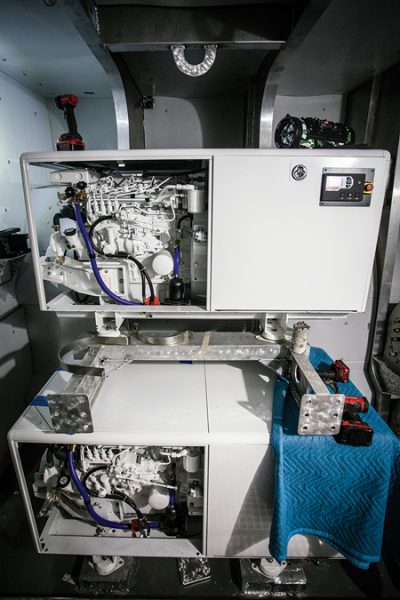
Two Northern Lights 38-kW gensets are the heart of H-2’s AC system, which also includes a 37-kW Atlas inverter to connect to shore power in foreign ports.
Much of the AC side was designed and specified by Ward’s Marine Electric in Fort Lauderdale, Florida, in cooperation with OceanPlanet Energy of Woolwich, Maine, and principal Bruce Schwab, who helped design and integrate the DC components. “Today there’s a big trend in the industry to use shore-power converters as inverters and superlarge lithium-ion battery banks to provide power, at least temporary power, for major loads like air-conditioning, chiller plants, and things like that,” said Ward Eshleman, chairman of Ward’s Marine Electric. “So, rather than using only smaller inverters and synchronizing them and stacking to get additional kW, the trend for the larger vessels is to use shore-power converters as inverters. There is an inverter bus in the main switchboard.”
True to its go-anywhere mission, H-2 was fitted with an Atlas 37-kW inverter to connect to shore power in places that do not serve 60 Hz, 240V single-phase power. “We can take anything from 90V to 400V and pretty much anything from below 50 Hz to the 60 Hz and single- or three-phase,” Herrin explained.
Eight GTX24V315A-F24 lithium-ion batteries from Lithionics are split between a house bank that can run all DC loads for at least 24 hours, and an emergency bank to operate critical DC loads—display screens, radios, nav lights—for 24 hours. The boat is equipped with 10 Solara Ultra-S 160W panels paralleled in two groups of five each, connected to two Victron SmartSolar MPPT 100/50 solar controllers to charge the house bank. Given enough sunshine, solar and battery power should be “capable of running lights and refrigeration but not air-conditioning or heating,” Schmitt said. “Since we will likely spend most of our time in the tropics, we did not believe that solar power alone could do the job we needed.”
OceanPlanet Energy specified four Victron Buck-Boost DC-DC converters, two for each engine, to help charge the house bank from the starter batteries without having to modify the engines’ stock alternators, which would have voided the warranty. “The converters activate based on the input voltage from the starting batteries,” Schwab explained. “With lower rpm, the alternators would not produce enough current to feed both converters without the starting-battery voltage dropping, turning the converters off. Then the voltage will rise, the converters turn on again, drop the voltage, turn off…over and over. Staggering the input voltage cut-in, hopefully starting the converters one at a time, will more smoothly supply power to the house bank across the engine/alternator rpm range.”

OceanPlanet Energy specified the DC system including DC/DC converters and hefty battery banks to power house loads and critical electronics.
There are two 4,500-watt 240V split-phase engineroom-ventilation fans connected to two Victron Quattro 5-kW 24V inverter-chargers configured for 240V/120V split-phase AC loads. They can accept AC inputs from two sources (shore power or generators) and automatically connect to the available source. “In the event of a grid failure or power disconnect, they take over the supply to the connected AC loads by inverting from the Lithionics house-battery bank,” Schwab said.
“It’s more complicated than that,” according to Herrin. “Typically, we’re going to be operating with the A-bus and the B-bus tied together, so we can power everything with one generator. The B-bus actually passes current through the Victron inverter-chargers on its way to the load. We have the ability to split the A-bus and the B-bus and run the A-bus on one generator and the B-bus on the other in the few instances we’re exceeding the capacity of one of the generators. If we lose both generators, then the essential loads are still going to be carried,” meaning engine vents or water pumps.
Redundancy and emergency backups also figured largely in the deliberations of John McKay, manager of the Switchgear Systems Division at Ward’s Marine Electric and point man for this project.
One of his challenges was limiting the voltage drop in the estimated 53 ‘ (16.2m) cable run between engines, which in an emergency allows the starboard engine to be started from the port battery and vice versa. “For a starter group, you can allow a 20% voltage drop,” McKay said and noted that starting the engines requires 720 amps, while the gensets needed only 200 amps. “I was keeping the 720-amp current between 7% and 11% voltage drop, getting up to some pretty good-sized copper. Some sections of the run were 240mm2 [500MCM] cable.” Knowing that the boat is capable of going to high latitudes, McKay recalled his youth and the frigid winter mornings in Massachusetts, “where you can crank a diesel all day long at a low rpm, and it’ll never start. You just need to turn it over one or two times at a higher rpm, and it’ll be running. So, I was making certain that the starter was going to crank at the highest rpm possible and not lose it all to voltage drop.”
Protecting Assets and Finishing the Job
No matter how fast or how far H-2 will travel, corrosion caused by galvanic current between dissimilar metals, by stray currents or by electric fault, is an enemy that needs to be kept in check. That’s the calling of Ted Schwartz, who runs Electro-Guard (Mount Shasta, California). He’s one of the country’s foremost experts on cathodic protection, and also served on ABYC’s E2 Cathodic Protection Project Technical Committee.
“We designed the system and supplied all the equipment and steered them through the installation,” Schwartz said. It’s a 15-amp impressed-current-cathodic-protection (ICCP) system, model 715 A-2, with three anodes and two reference cells. Regarding the boat’s Evolution shaft system with driveshafts running inside an oil-filled tube, Schwartz said: “It was a real challenge because you can’t actually make contact with the propeller shaft on the inside of the boat.” He consulted with Soundown and found a solution. “At the coupling on the inboard end of the tube, a bit of the shaft stuck out through the seal,” Swartz said. “There’s this coupling that Soundown built that fastens to the shaft, and we asked them to provide a surface on that coupling where we could put our silver slip rings on [to provide an electrical connection] to protect props and shafts.”
Every anode can deliver up to 5 amps of current using its own current controller that receives a signal from the main controller, which determines exactly how much current each anode will put out. The entire system consists of three anodes, three current controllers, the main controller, and a separate monitoring station connected to the controller by signal cable. Later, Schmitt also ordered a backup system employing aluminum sacrificial anodes.
On catamarans, the company installs a reference cell aft near the prop of each hull, and an anode on the aft section of each hull, and one anode amidships on the inboard side on one hull.

Chromate, two layers of epoxy, copious amounts of fairing compound, and various primers rendered the surface fair and ready for a yacht-quality paint job.
At the time of this writing, the vessel had been shot with chromate and two layers of epoxy before approximately 500 gal (1,893 l) of fairing compound and 325 gal (1,230 l) of various primers rendered the surface fair and ready for a yacht-quality Alexseal paint job with 35 gal (132.5 l) light ivory, 24 gal (91 gal) stark white, and 2 gal (7.6 l) cordovan gold. Parallel to the exterior, construction was on the home stretch with installation of the crew quarters and the saloon overhead. On the systems side, pressure checks were performed for hydraulics and plumbing.
Since H-2 is a much larger and more complex vessel than the original Hippocampus , with a multitude of systems that need to be managed, monitored, and maintained, I was curious how many crew Schmitt was planning to hire to help run his new boat. He said he consulted with captains and headhunters, and “the consensus is three or possibly four at most. I just completed my 100-Ton Masters and will build time on the new boat as well. We won’t charter and are not accustomed to being cooked for or served or having our beds made and all that. So mostly I’m looking for a qualified captain and engineer to maintain the systems.”
Little surprise that a hands-on operator like Schmitt does not want to cede too much of the game he loves to play. But as big, bold, and broad-shouldered as H-2 will be when she finally emerges from the old Gunboat shed in Wanchese, the proud owner is quick to remind anyone that it’s still “a vehicle to get the toys wherever.”
H-2 : The Designer’s View
H-2 ’s owner, the adventurous Brian Schmitt, has dived into deep caves to see submerged caverns, hand-fed large sharks that would normally view him as food, and spent years in his off-time exploring Caribbean archipelagos in Hippocampus, his current 19-year-old 57 ‘ (17.4m) power catamaran. Nearing retirement age, he gave the order for his “ultimate” yacht.

The foldable hydraulic deck crane to launch and retrieve a two-man electric submarine or an all-terrain vehicle required cutting a slot in the helicopter deck for the lifting bridle.
The first talk about the new design was between the owner, the builder, and me. As we discussed the mission of the boat, it became clear that it would fall into the category of expedition vessel with more guest staterooms, more range, and more room for equipment than his old boat. Brian defined the function of the vessel as a carrier for a 26 ‘ (7.92m) twin-outboard catamaran, an outboard skiff, a small car, and a small helicopter, which needed a flight deck. This vessel was to be used with family and guests while also serving as an operations base for outbound travel by air, land, or sea.
Aside from commodious accommodations, a key requirement was comfortable motion on rough seas. This was to be a catamaran, like his current boat, which offers extensive real estate afloat in a seagoing vessel. The only restriction for the new design was a beam no greater than 35 ‘ (10.6m) to fit the largest Travelift.
The trade-off for overall beam width involves room versus roll motion. A wider catamaran responds more quickly to roll in seaways but with less amplitude, whereas a narrower beam rolls more slowly with slightly more amplitude. The slower roll is preferable as long as overall roll stability is maintained. Roll in catamarans is unlike roll in single-hulled vessels. Because the vessel is supported by two buoyancy chambers (hulls) with distance between them, motion has little to do with roll inertia, but rather with response of the hulls to the seaway. Each hull responds to a passing wave independently by heaving (up/down) and rolling, which is a circular motion around the center of gravity (CG) that translates to lateral motion when standing above the CG, especially high up on the bridge. Power catamarans, unlike sailing catamarans, do not require wide hull spacing to generate righting moment (to support a sail plan), so they can have closer hull spacing, which still preserves sufficient stability, slows wave-response roll characteristics, and takes up less space in port.
One of the expected routes for this vessel is the Northwest Passage over the top of North America. Boats venturing there can expect floating ice, so we added thicker hull plating at the waterline and an ice-separation chamber on the cooling water intakes. We also designed the hull to give the propeller protection by positioning it behind a deep canoe-stern afterbody with no exposed shaft. A rudder horn, below the propeller extending aft from the hull, adds support for the rudder and protection for the prop. This configuration is useful as a hedge against the possibility of grounding. In fact, this boat can be careened on the beach between tides if necessary for repairs. The hull includes a strong, deep, vertical keel structure that allows for blocking anywhere along its length.
Speed and range became the largest determinates of the design. A maximum range of 4,000 miles at 15 knots (enough to cross the Atlantic Ocean) was proposed. Catamarans are easily driven at modest speeds due to lack of significant wave resistance by narrow hulls. A preliminary speed prediction analysis showed that we would be in the ballpark with about 1,400 hp (1,050 kW) and 5,000 gal (18,925 l) of diesel per hull. The final installed fuel capacity is 12,500 gal (47,313 l).

The general arrangement plan shows crew quarters in the hulls, three guest cabins, office, saloon, and galley on the main deck and owner’s suite on the bridge deck level.
A totally new design normally goes through a lengthy proposal and critique cycle between designer and client, especially if the client is knowledgeable and involved. The vessel’s first iteration started at 90 ‘ (27.43m) LOA, but it became evident that it needed more length to relieve a number of ills. After adding 10 ‘ (3.05m) we saw improvements, but it wasn’t until the 110 ‘ (33.5m) length proposal that we felt all the requirements had been satisfied: more slender hull shape, more open interior space, and better placement of machinery and tankage. The flight deck for the helicopter became larger, and the forward superstructure fairings gave the boat a sleeker look. And at 110 ‘ we achieved an efficient length versus waterline beam ratio that reduced wave drag and fuel consumption at the target cruise speed.
While beam remained at 35 ‘ , lightship displacement increased significantly to 230,000 lbs (104,190 kg). Accommodations now include crew quarters for four persons in the bows; three double guest cabins and a ship’s office forward; a large saloon amidships with adjacent galley, and a dive and a storage locker aft on the main deck. The upper deck is arranged with a full-width-bridge steering station forward, protected by a Portuguese bridge, and a master stateroom with en suite bathroom aft. The flight deck extends aft of the master stateroom. Access to the upper deck is by either a staircase from the foredeck, an interior staircase adjacent to the ship’s office, or by stairs from the starboard side deck.
The largest variable weight on the boat is fuel, so the tankage is located amidships to minimize its influence on trim. Engine and machinery rooms aft of the tankage take up the remaining spaces all the way to the transoms. Other amenities include a utility area aft of the crew quarters port side with storage and washing machines, and a walkway through the tank spaces and enginerooms to the boarding decks at each transom. Another late addition is the flying bridge to aid with shallow-water operation by improving the vantage point to see coral heads and other obstructions. Its protective bimini serves as a mounting platform for lights and antennae.
—John R. Marples
Read more Construction , Design , Drawing Board , Yards articles

- SNAME Powerboat Symposium Is Back
The Society of Naval Architects and Marine Engineers (SNAME) Technical and Research Program, in cooperation with the Hampton Roads, Virginia Section of SNAME, will host the Sixth Annual Powerboat Symposium… Read more »
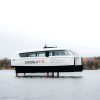
- Candela’s Faith in Foiling Ferries
In the rarefied world of fully foiling electric boats with carbon hulls and appendages, sensor-based digital ride control systems, and hefty price tags, Candela grabbed the spotlight by delivering on… Read more »

- Australia II Wing Keel Controversy – Part 2
A tank-testing laboratory team in The Netherlands convinced Australian challengers to rely on performance-prediction data and analysis that helped create the 12-Meter that made America ’s Cup history.

Recent Posts
- Australia II Wing Keel Controversy – Part 1
- Learn Electrical Systems from Nigel Calder
- Companies (83)
- Construction (105)
- Design (160)
- Drawing Board (10)
- Education (25)
- Environment (16)
- Events (21)
- Materials (49)
- Obituary (17)
- People/Profiles (48)
- Products (16)
- Propulsion Systems (32)
- Racing (16)
- Repair (37)
- Rovings (315)
- Short Cuts (3)
- Sponsored Partner News (13)
- Systems (80)
- Task Sheet (1)
- Uncategorized (26)
- Wood to Glass (7)
ProBoat.com Archives

Catamaran Vs Monohull

Last Updated by
Daniel Wade
August 30, 2022
Monohulls and traditional sailboats, once ubiquitous, are giving way to modern catamarans. But how do these designs differ?
Monohulls have a single hull, and catamarans have two hulls side-by-side. Catamarans are faster than monohulls of the same length and displacement, but monohulls are stronger and more spacious. Monohulls are also cheaper and easier to build than multi-hulls.
In this article, we’ll cover the differences between catamarans and monohulls, along with the benefits and drawbacks of each design. We’ll also cover the sailing characteristics of each and why catamarans so easily outrun equivalently-sized monohulls.
We sourced the information used in this article from trusted sailboat design resources, along with manufacturer specifications and boat market analysis.
Table of contents
What is a Catamaran?
Catamarans are a kind of multi-hull sailboat with two hulls joined together. They are often short and wide, resembling a square or rectangle from above.
Catamarans are colloquially distinct from outriggers, which are double-hulled vessels with one large primary hull and a small outboard stabilizing hull.
Catamarans usually have hulls that mirror each other, both in size and arrangement. Sometimes, the interior layouts are mirrored, too—but this varies between designs and manufacturers. Catamaran hulls are narrower and taller than most monohull designs of equal lengths.
Catamarans have limited commercial and military utility, as these applications favor space and ease-of-construction over handling characteristics. That said, there are some commercial uses for catamaran designs—most commonly passenger and car ferries.
What is a Monohull Sailboat?
A monohull is probably what you traditionally think of as a boat. Monohulls are longer than they are wide. It features a single hull—it’s that simple. Sailing monohull designs have evolved over the centuries into many distinct types, usually distinguished by keel type.
Monohulls come in many shapes and sizes . For example, sailing monohulls designed for offshore use have long keels that sometimes extend much further below the waterline than the freeboard and cabin extend above it.
Monohull sailboats are also designed for other purposes, such as inland sailing and racing. These vessels have more contemporary characteristics, such as rounded shallow ‘canoe’ bottoms, V-bottoms, and fin keels.
Monohulls aren’t just sailboats. Virtually every cargo and container ship, warship, and many passenger ships are monohulls due to their strength, ease of construction, and high cargo capacity.
Are Monohull Sailboats More Common?
Monohulls are more common in every application, though multi-hulls are becoming more common for ferries. Monohulls have numerous benefits over multi-hulls, and these benefits only increase with scale.
Monohulls are easy to construct. They’re also cheap. Large monohull ships, such as container ships, can be built with very little material and effort. This is because the vast majority of the length of a monohull is just a box, with a bow and stern welded onto the end.
Sailboat construction is more intricate, but the costs are still lower. Plus, monohull designs are robust, and cabin space is plentiful. There’s a lot more study in the field of monohull design, which was the universal truth until somewhat recently.
But all in all, the reason why monohull sailboats are more common is that they work just fine. Most sailboat owners aren’t interested in breaking speed records or hosting dozens of people aboard their boats. As a result, a standard, simple, and easy-to-control monohull are more than sufficient.
Are Catamarans Faster than Monohulls?
Catamarans are most certainly faster than monohulls. This is almost always the case. Even the fastest production monohulls can’t hold a candle to the average cruising catamaran.
But why is this the case? Aren’t catamarans restricted by the same hydrodynamic forces as monohulls? As it turns out, they aren’t. This has to do with the unusual way hull waves impact speed.
Hull Speed Limitations
Monohull speed is limited by something called hull speed. Hull speed is determined using a formula that calculates the maximum speed a displacement hull can travel under normal power and conditions.
When a displacement hull moves through the water, it kicks up a set of waves at the bow and stern. These waves travel along the side of the vessel and create drag, which slows down the boat. Normally, the power of the wind can overcome this drag—but only to a point.
At a certain speed, the waves kicked up by the bow will sync with the waves kicked up at the stern and begin ‘working together’ against the boat. The speed at which this occurs is the hull speed, which is calculated from the length of the boat.
Hull speed limitations for monohulls aren’t universally true all the time. Some vessels exceed it, and some don’t—but the number is a useful estimate of the limitations of monohull designs. Modern monohulls with clever hull shapes can defeat hull speed calculations.
Do Hull Speed Limitations Apply to Catamarans?
Surprisingly no—hull speed calculations don’t work for catamarans. This is because, for one, the hulls are shaped differently. Alone, catamaran hulls wouldn’t float correctly. But together, they create different hydrodynamic effects and cancel out the effects of hull speed.
This means that catamarans can easily exceed the speeds of even the fastest monohulls of equal length—and sometimes beat them by a margin of 50% or more. It’s not unheard of for 40-foot catamarans to exceed 20 knots, whereas 40-foot monohulls rarely get past 10.
Are Catamarans More Comfortable than Monohulls?
Catamarans can be much more comfortable than equivalently-sized monohulls—up to a point. This is because catamarans engage in ‘wave piercing’ and have a wider and more stable footprint on the water.
Catamaran hulls, when properly designed, can slice through parts of a wave instead of riding over every peak and trough. This effectively reduces the height of the weight, which reduces the amount the boat rolls.
Additionally, the wide footprint of a catamaran allows some waves to simply pass right under it, keeping the boat level for longer durations. Catamarans also don’t heel under sail—instead, they plane slightly, raising the bows out of the water and reducing bumps.
Monohull Benefits
Monohulls are proven in all conditions. A well-designed displacement monohull sailboat can ride out the strongest storms, and monohull workboats can support enormous loads and move them efficiently. They can be fast, comfortable, and also easy to sail (even for beginners).
Monohulls are cheap to build and forgiving, as precision doesn’t have to be microscopic to get them to sail right. They’re robust and strong, featuring a naturally stress-resistant hull shape. They’re also easy to modify and aren’t required to meet as strict of dimensional ratios to operate.
With a monohull sailboat, you have a lot of interior room to work with. This means that monohulls are available in numerous cabin layouts and are just as easy to modify as they are to build. Monohulls often have a center of gravity at or below the waterline, which enhances stability at steep heel angles.
On the water, displacement monohulls can weather extreme conditions with ease. They lack the initial stability of multi-hulls, but they can recover from knockdowns on their own, and they’re very difficult to push past their rollover point.
Why do Catamarans Cost More than Monohulls?
Catamarans cost more than monohulls because they’re more expensive to build, more complex to engineer, and require more material. This isn’t always the case, but the design of catamarans requires much more careful engineering and strength-of-materials analysis than comparatively simple monohulls.
There are several critical structural points on catamarans that monohulls lack. In fact, the very shape of a monohull is physically strong—so it has inherent durability. Catamaran hulls must be joined in the middle, and the mast must have a strong point far from the inherently sturdy hulls.
This requires stronger materials and more care during design or construction. This is why catamarans remain a premium part of the sailboat market and why they still aren’t the most popular sailboats despite their numerous performance and comfort benefits.
Catamaran Cabin Layout
Catamaran cabins are split between the two hulls, and there’s usually a large pilothouse in the center. Pilothouse catamarans can be quite spacious, primarily due to the large space between the hulls.
The pilothouse is usually where kitchen and sitting areas are located, along with cockpit access and the controls of the sailboat. The mast is also located in this area.
Catamaran cabins sometimes mirror each other. For example, each hull may contain two identical bedroom/bathroom combos, while the center console area contains the kitchen and living spaces.
The two identical hulls sometimes make for unusual design decisions (such as small catamarans with four master bedrooms), but owners say this gives their passengers a much better experience than a monohull cabin.
Monohull Cabin Layout
Monohull cabins, with the exception of split-cabin sailboats with a center cockpit, have only one large interior space to work with. It’s usually much wider than catamarans of equal length.
Monohull cabins are usually accessible from the bow (via a flush deck hatch) and the stern via a traditional companionway. They run the span of the hull between the bow and the cockpit and sometimes include spare berths under the cockpit seats.
These spare berths are often used as convenient sea cabins, as they offer quick access to controls in case of an emergency. Catamarans often have convertible berths in the center console for the same reason.
Monohull cabins are traditional and include everything that catamaran cabins do—albeit with slightly less room overall. That said, individual spaces are often much wider, and facilities are more appropriate.
Related Articles
I've personally had thousands of questions about sailing and sailboats over the years. As I learn and experience sailing, and the community, I share the answers that work and make sense to me, here on Life of Sailing.
by this author
Learn About Sailboats
Most Recent

What Does "Sailing By The Lee" Mean?
October 3, 2023

The Best Sailing Schools And Programs: Reviews & Ratings
September 26, 2023
Important Legal Info
Lifeofsailing.com is a participant in the Amazon Services LLC Associates Program, an affiliate advertising program designed to provide a means for sites to earn advertising fees by advertising and linking to Amazon. This site also participates in other affiliate programs and is compensated for referring traffic and business to these companies.
Similar Posts

Affordable Sailboats You Can Build at Home
September 13, 2023

Best Small Sailboat Ornaments
September 12, 2023

Discover the Magic of Hydrofoil Sailboats
December 11, 2023
Popular Posts

Best Liveaboard Catamaran Sailboats
December 28, 2023

Can a Novice Sail Around the World?
Elizabeth O'Malley
June 15, 2022

4 Best Electric Outboard Motors

How Long Did It Take The Vikings To Sail To England?

10 Best Sailboat Brands (And Why)
December 20, 2023

7 Best Places To Liveaboard A Sailboat
Get the best sailing content.
Top Rated Posts
Lifeofsailing.com is a participant in the Amazon Services LLC Associates Program, an affiliate advertising program designed to provide a means for sites to earn advertising fees by advertising and linking to Amazon. This site also participates in other affiliate programs and is compensated for referring traffic and business to these companies. (866) 342-SAIL
© 2024 Life of Sailing Email: [email protected] Address: 11816 Inwood Rd #3024 Dallas, TX 75244 Disclaimer Privacy Policy
The Illustrated Guide To Boat Hull Types (11 Examples)
I didn't understand anything about boat hull types. So I've researched what hulls I need for different conditions. Here's a complete list of the most common hulls.
What are the different boat hull types? There are three boat hull categories: displacement hulls, which displace water when moving; planing hulls, which create lift at high speeds; and semi-displacement hulls, which displace water and generate lift at low speeds. The most common hull types are round-bottomed, flat-bottomed, multi, V-shaped, and pontoon hulls.
But that's all pretty abstract if you ask me, so below I'll give a simple overview of what it all means. After that, I'll give a list with pictures of all the different designs.
A Simple Overview of Boat Hull Types
Your boat hull will be the biggest factor in how your boat handles or sails, how wet it is, how bumpy - absolutely everything is determined by the hull shape. So it's important to understand what different hulls will do for you, and what each hull is best for. First, let's slice it up into rough categories.
Roughly, you can divide boat hulls into three categories:
- Displacement hulls - Lie inside the water and push it away when they move
- Planing hulls - Lie on top of the water and don't push it away
- Semi-displacement hulls - Lie inside the water and push it away, but can generate lift
Everything I'll be mentioning below is one of those three, or something in between.
There are five common boat hull types:
- Round-bottomed hulls - handle well in rough water: sailboats
- Flat-bottomed hulls - very stable for calm inland waters: fishing boats
- Multihulls - very stable and buoyant: catamarans
- V-Shaped Hulls - fast and comfortable in chop: powerboats
- Pontoon hulls - fast and stable: pontoon boats
And then there's everything in-between.
Here's a quick and handy overview of the different hull types
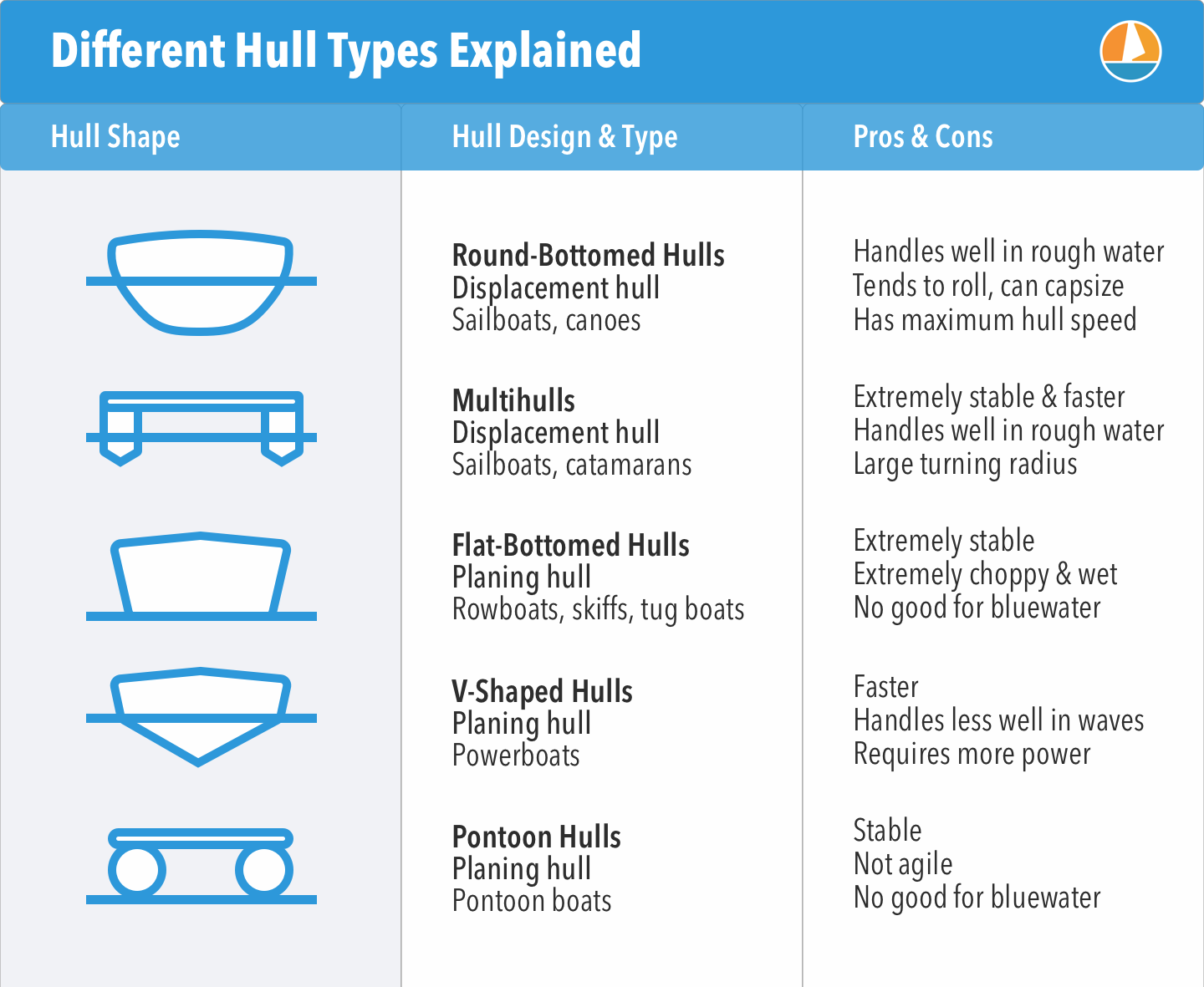
In each category, we find different designs and styles that have different characteristics. There isn't a real clear distinction between categories and styles: there are semi-displacement hulls and so on. So I thought the best way to learn you the different hull types is by simply creating a list with lots of pictures, instead of getting all theoretical about it.
So below I've listed all the different hull styles I could possibly think of, mention what category and type it is, the pros and cons of each one, and give you examples and illustrations for each one.

On this page:
Displacement hulls, round-bottom hull, catamaran hull, trimaran hull, planing hulls, flat-bottom hull, deep v-hull, modified-v hull, stepped hull, pontoon hull, semi-displacement hulls.
Examples: Sailboats, trawlers, fishing boats
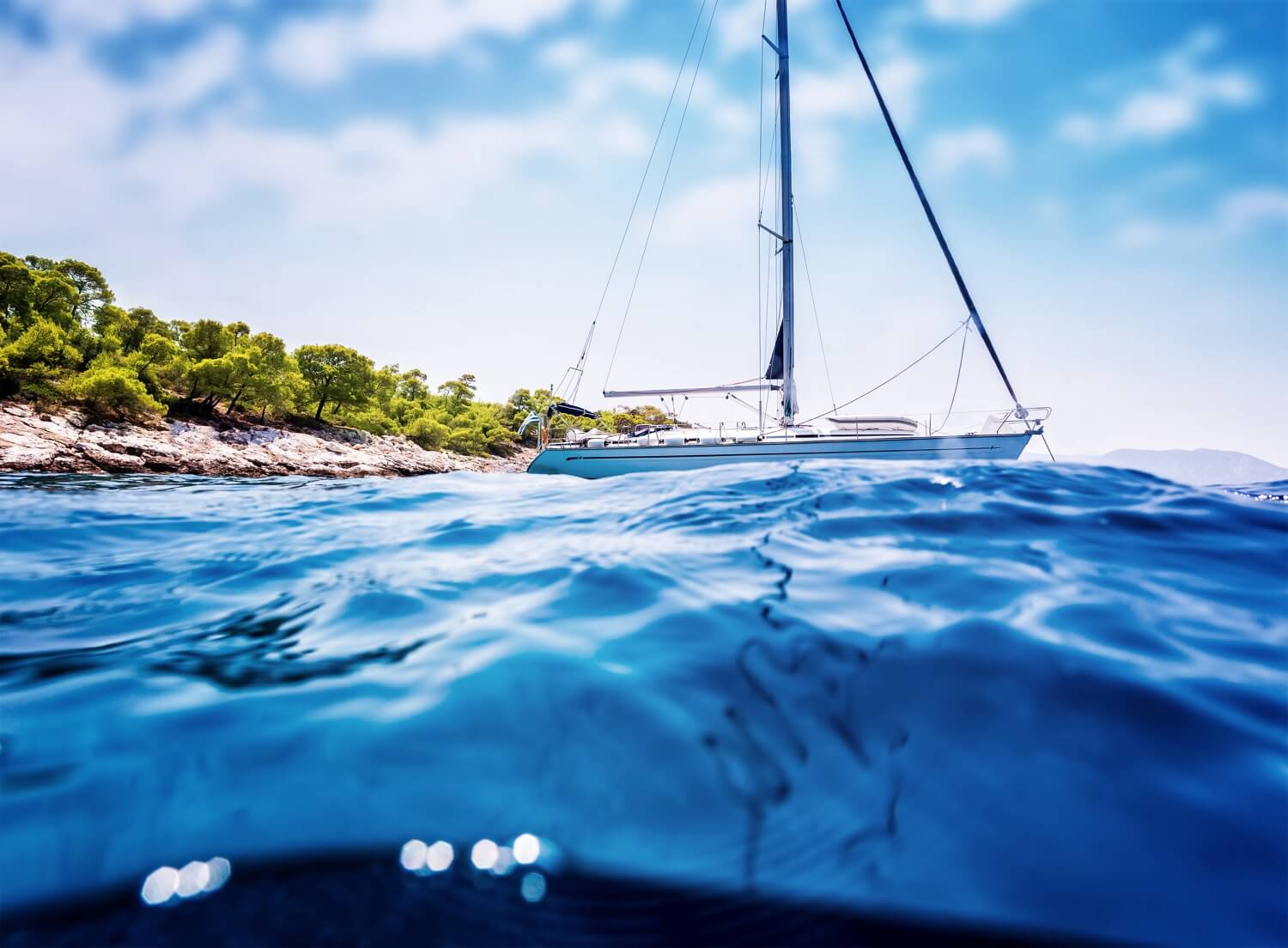
Displacement hulls displace water when moving. These hulls lie in the water, instead of on top of it. The amount of water they displace is equal to the boat's weight. Displacement hulls handle way better in rough waters than flat-bottom hulls. That's why most cruisers have some sort of displacement hulls. There are actually all kinds, shapes, and forms of the displacement hull design, which we'll go over later.
The most important thing to understand about the displacement hull, is that it operates on buoyancy. This means that most of the boat's weight is supported by its capacity to float . Planing hulls, on the other hand, operate on lift instead, but we'll dive into that later.
Sailboats typically have displacement hulls, but also fishing boats, trawlers and crabbers. All in all, it's used for each boat that needs to handle well in rough conditions.
Learn everything there is to know about displacement hulls in this article . It lists all the pros and cons and really goes into detail on the nitty-gritty about how displacement hulls actually work .
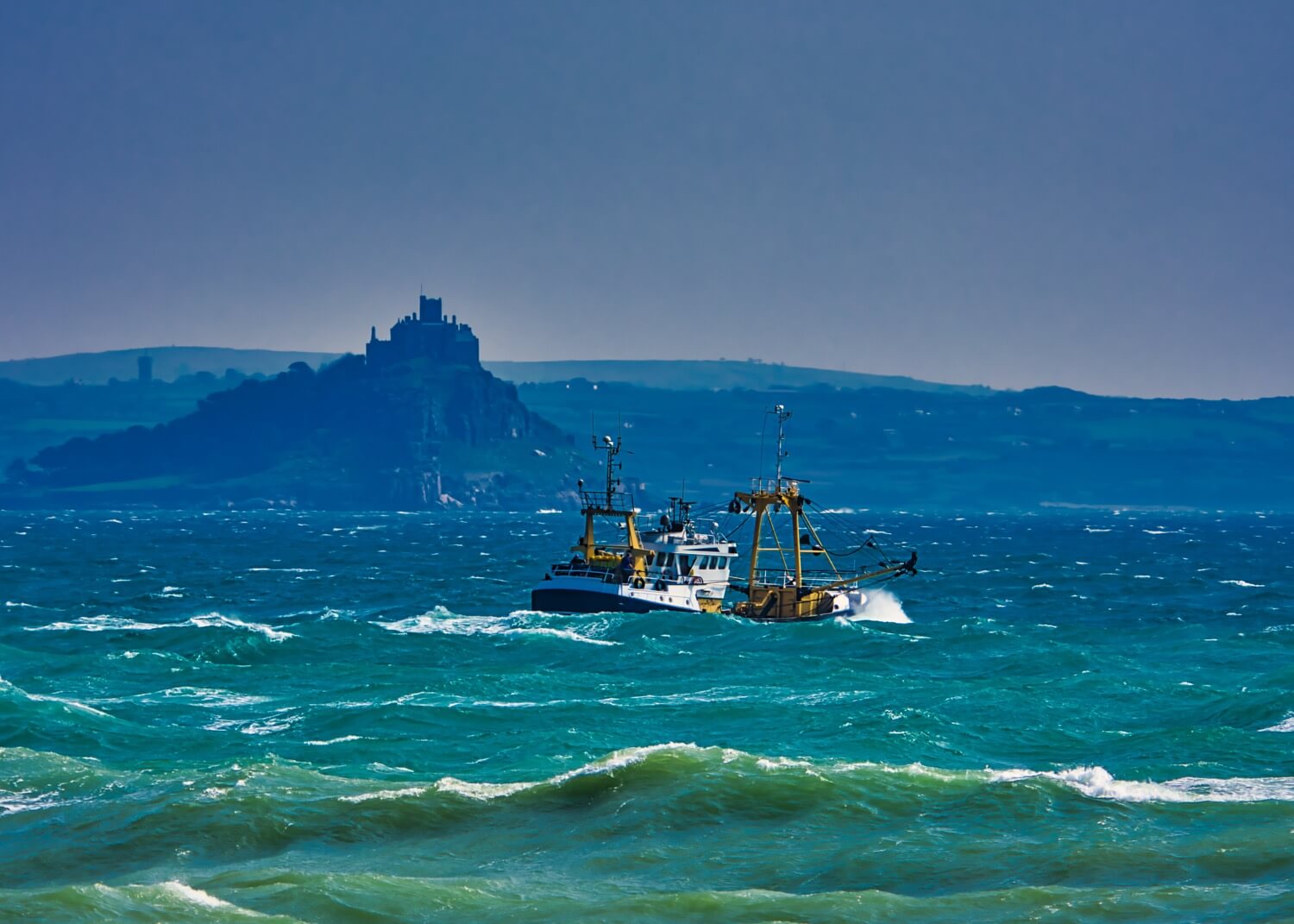
But they are also slower than flat and planing hulls because the boat creates more resistance when moving. It has to push the water aside. In fact, this type of hull has a built-in upper-speed limit.
This upper-speed limit is called maximum hull speed . It means that the length of a displacement hull directly determines the maximum speed. It can't go faster, because the water-resistance increases with the boat's speed. To learn everything about calculating maximum hull speed , please check out my previous article here.
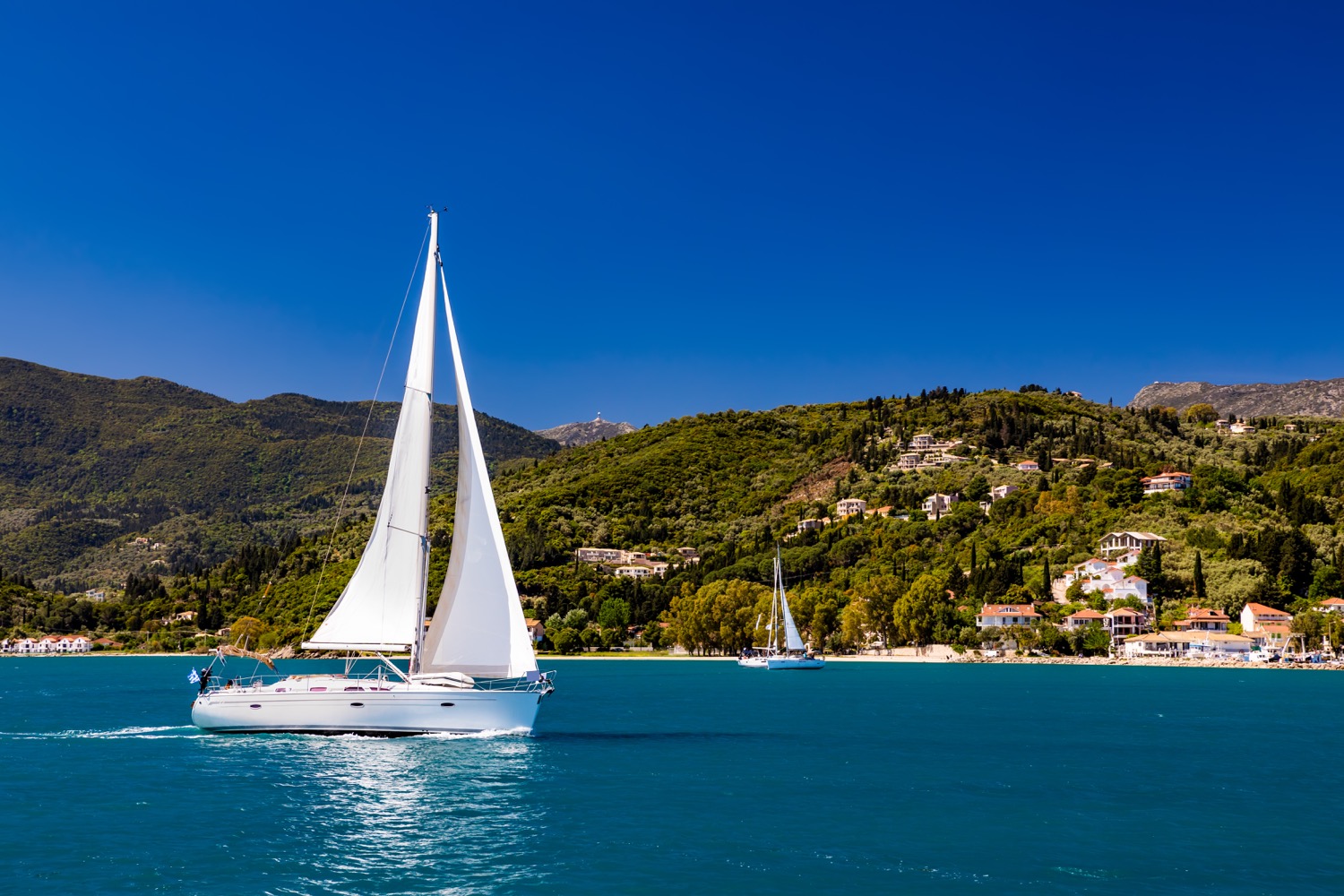
A round-bottomed hull is a type of displacement hull - it lies in the water and has to power through it. But since it's rounded, it creates little resistance and is effortless to move through the water. It's a very smooth ride and typical for any sailboat that sort of glides through the waves. In contrast, powerboats really have to eat their way through the water.
Examples: Canoes, sailboats
They are also one of the least stable. Since the bottom is rounded, your boat or canoe will rock plenty when boarding or moving around. They are also easy to capsize. That's why pro canoers learn to do a 360 in their canoes. I've never did a roll myself but came close enough a couple of times.
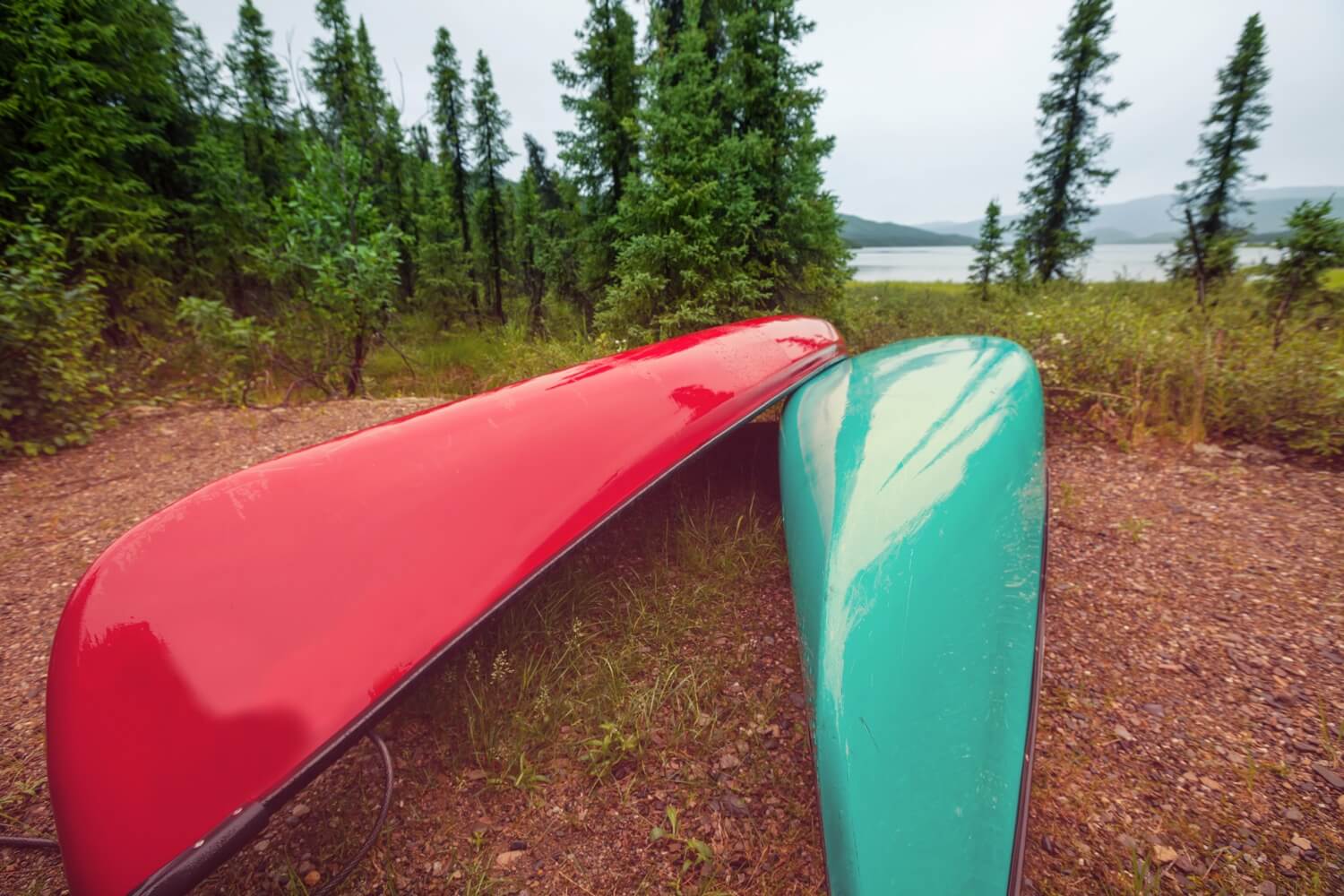
Almost all sailboats use a round bilge as well. This provides it its buoyancy and makes sure it handles well in waves. But since a rounded bilge is easy to capsize, a lot of sailboats have some sort of keel, which stabilizes the roll.
Nearly all ocean-going vessels use some sort of displacement hull, and the round bottom is the most common one. But our next guest is very popular as well.
The catamaran is similar to the pontoon hull (read on to learn more on that one), but it is a displacement multihull instead of a planing one. So it has two hulls, that lie inside the water and displace it. Like the pontoon, you will have to try really hard to capsize this design (and it won't work).
Examples: well, catamaran sailboats. But also this cool catamaran trawler:
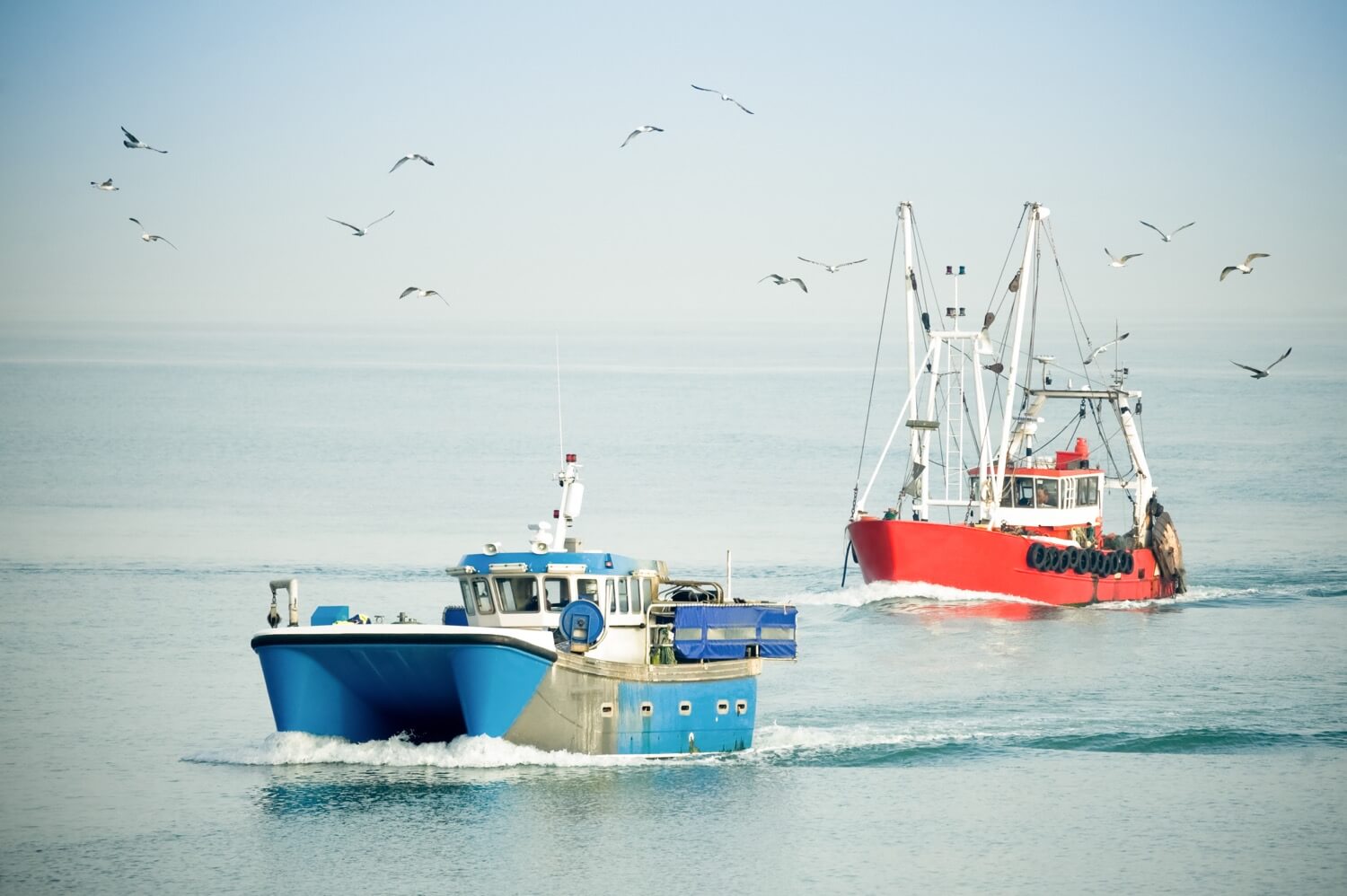
Catamarans are extremely popular ocean cruisers. Their biggest pro is their extreme stability and buoyancy. And they have a very shallow draft for a displacement hull, making them very popular for sailing reefs and shallow waters, like the Caribbean.
Some cons for the catamaran are less agile than monohulls. They have a large turning radius, making them less maneuverable. Also, expect to pay high marina fees with this one.
Speaking of marina fees, our next one can go either way.
I think trimarans are incredibly cool, and especially the second type.
There are two types of trimarans:
- a catamaran with three hulls instead of two,
- or a displacement monohull with two floaters.
The first has the same characteristics as the catamaran: it's a displacement multihull, but now with three hulls:

The second can be a regular displacement monohull, with two pontoon-type floaters that provide extra buoyancy, making the total thing a hybrid between pontoon and displacement:
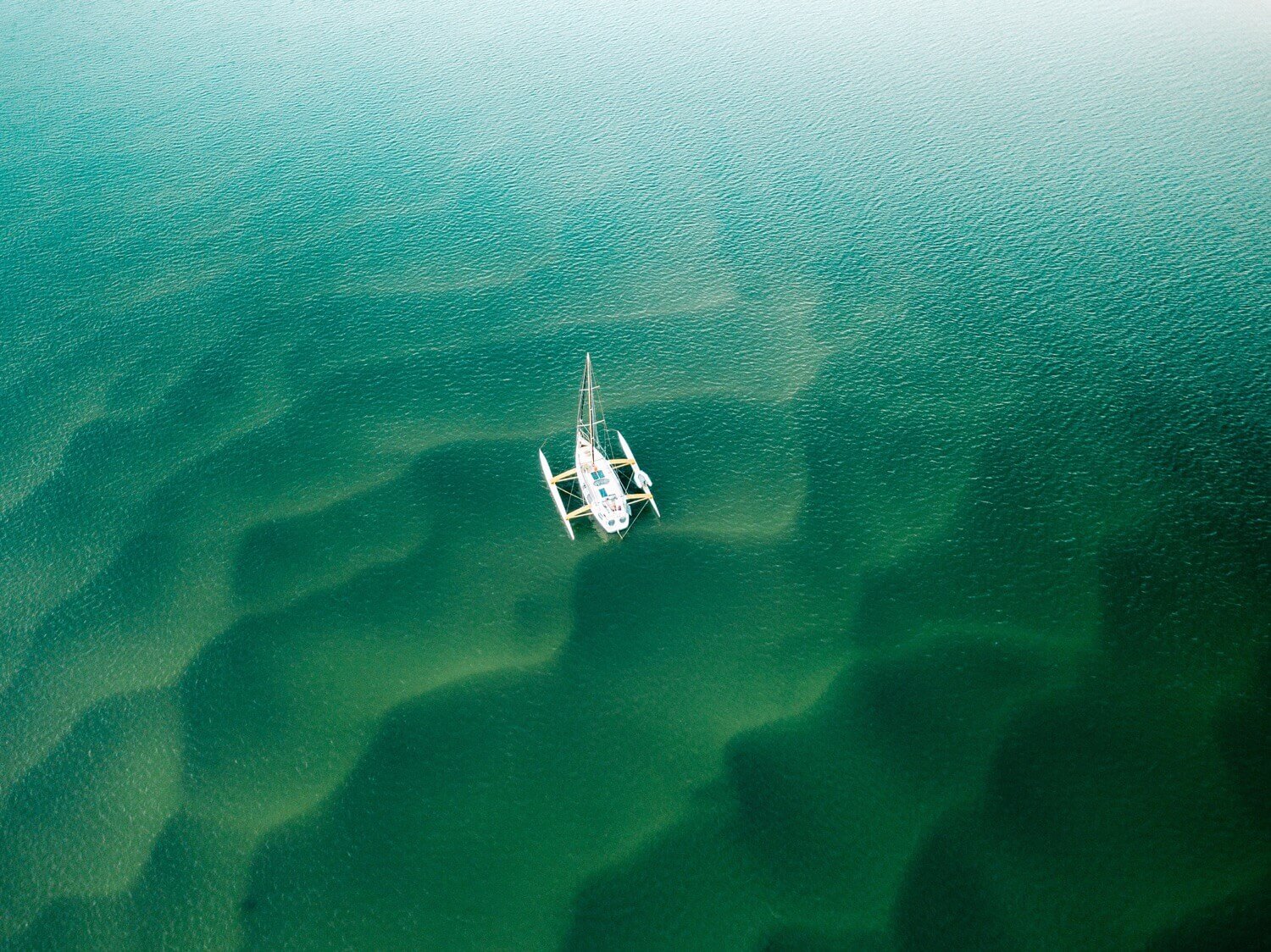
This last one has all the pros of a catamaran in terms of stability, but: you can simply wheel in those floaters whenever you head for port. That saves you a lot of money. And you can trailer her! Imagine that, a towing a trimaran home.
So those were the most common displacement hulls, aka what lives in the water. Let's move on to the planing hulls, aka what lives on the water.
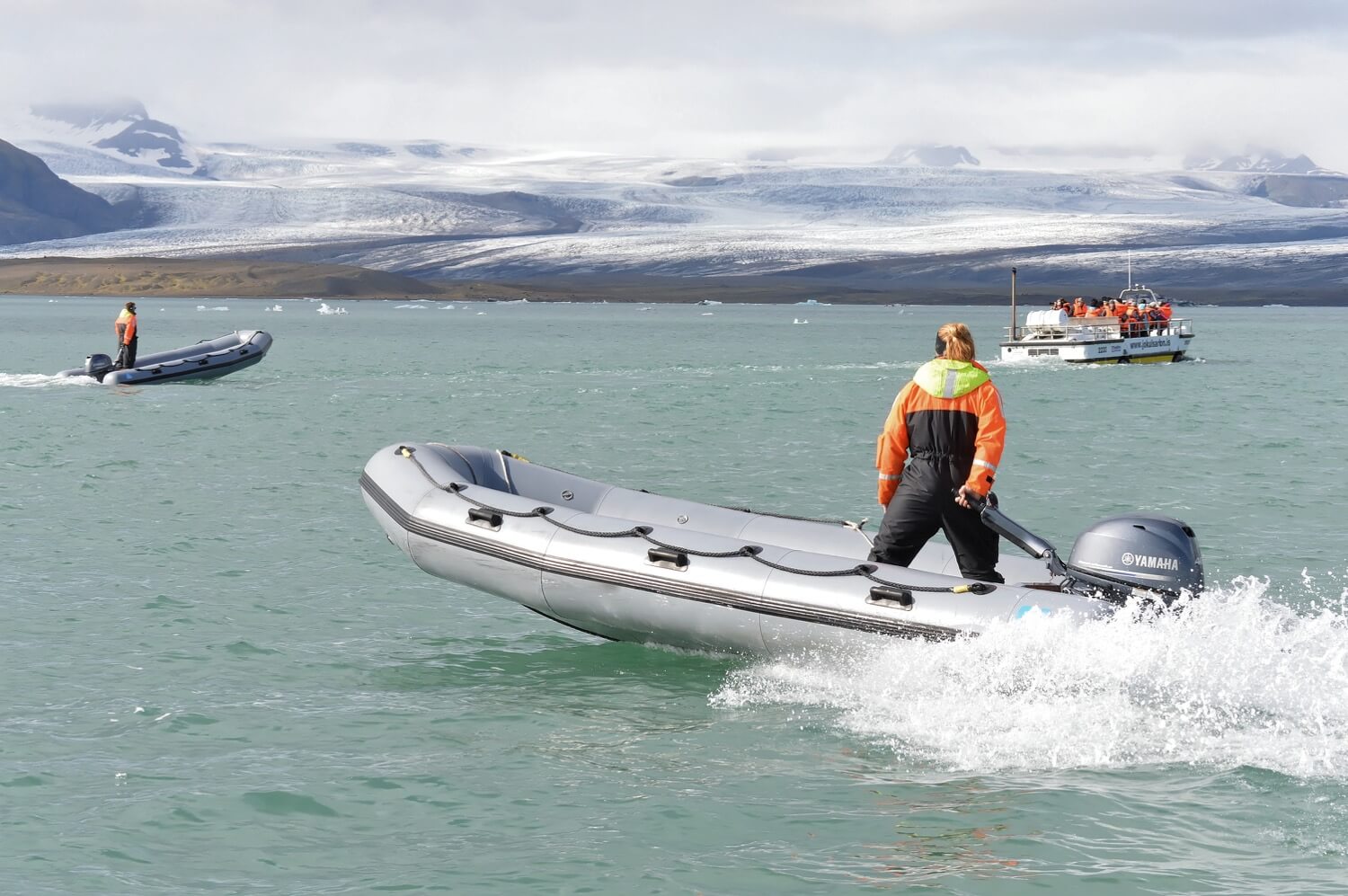
Planing hulls are a hybrid between the flat-bottom and displacement hulls. Planing hulls displace water at low speeds , but create lift at higher speeds . The shape of their hull + speed lifts them out of the water, making them glide on top of the water. Most powerboats look like flat-bottom boats but use a shallow V-shape that helps the boat to handle better at higher speeds.
Examples: Water sports boat, powerboats
The most important thing to understand about planing hulls is that they operate mainly on lift instead of buoyancy. This means the weight of the boat is mainly supported by dynamic forces 1 . With the right amount of power, this design generates lift, which results in less resistance. This is why they are a lot faster than boats with displacement hulls, but also a lot rougher, even with mild chop.
A lot of powerboats use some sort of planing hull. Again, there are many designs and variations on the planing hull, and I'll try to mention as many as I can below.
Because the wedge of the hull runs into the water, it is much easier to handle at high speeds. At lower speeds, it is able to keep its course, even with a bit of wind. However, whenever the boat starts planing, it is prone to wind gusts, since the wedge shape no longer stabilizes the boat.
The flatter the hull, the faster it will go, but also the more poorly it will handle. Other powerboats use deep V-hulls, which I'll discuss below. But first, let's take a look at the flattest hulls you'll ever see.
A flat-bottom hull lies on top of the water and doesn't displace water (okay, very little) as it moves. Since there is no displacement, there is also little to no friction when moving. This makes it potentially fast, but it handles pretty poorly. It is one of the most stable hull design.
Examples: rowboats, (old) high-performance powerboats, small skiffs, small fishing boats, tug boats
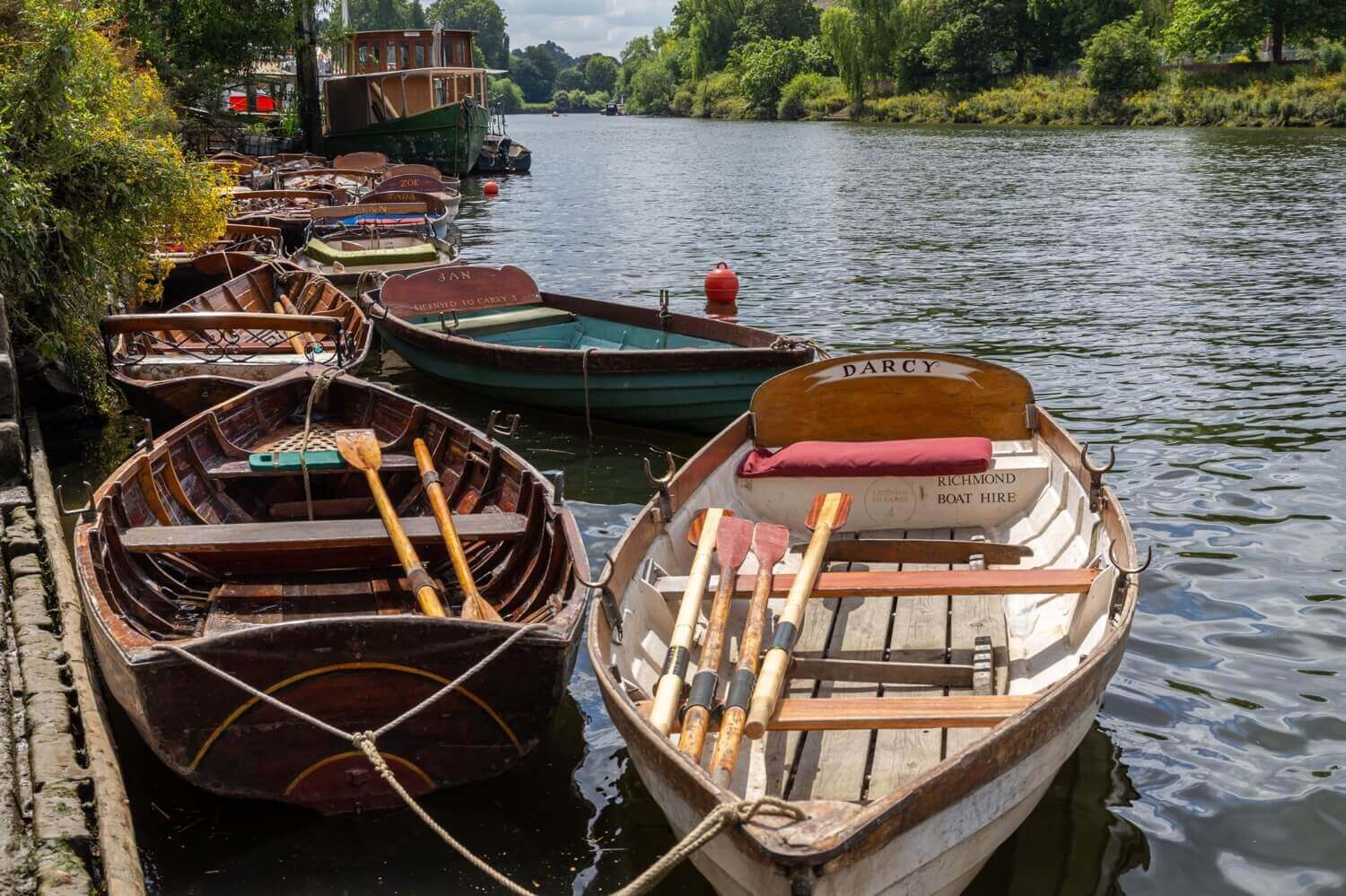
They aren't just incredibly stable, they're also very practical. Because the bottom is practically flat, they maximize boat surface. But they are also extremely choppy in rough weather and waves. They will handle very poorly with stiff winds, as the wind can simply catch them and blow them across the water surface. That's why this design is almost exclusively used for calm, small, inland waters.
This type of hull operates mainly on buoyancy , like the displacement hull, but it doesn't require the same amount of power to propel, which is why it's faster.
Because of the uncomfortable ride, not a lot of boats use a perfectly flat bottom. Most boats nowadays use some sort of v-hull or hybrid design, like a semi-displacement hull; especially larger boats. So not a lot of boats have a real flat bottom. However, we do call a lot of boats flat-bottomed. How come?
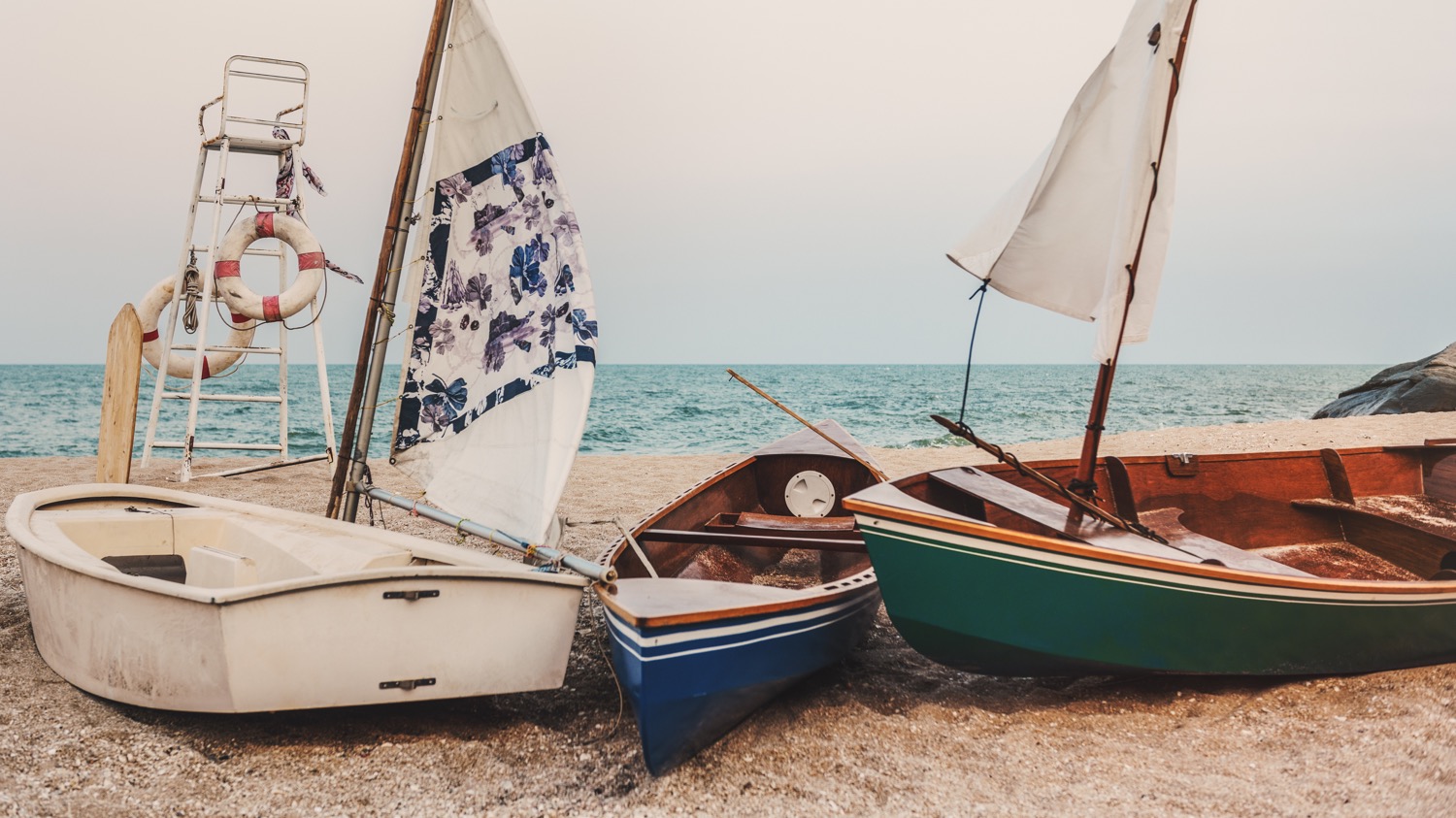
There are two types of hulls we call flat-bottoms:
- Of course boats with an actual flat bottom
- Boats with almost no deadrise
What is the hull's deadrise? The deadrise is the angle of the front of the hull to the horizontal waterline.
As you can see, the green sailing dinghy in the picture above has a deadrise that's barely noticeable.
Let's move on to other variations of the planing hull. One of the most popular hull design for modern-day powerboats is the Deep Vee hull. And that's as cool as it sounds.
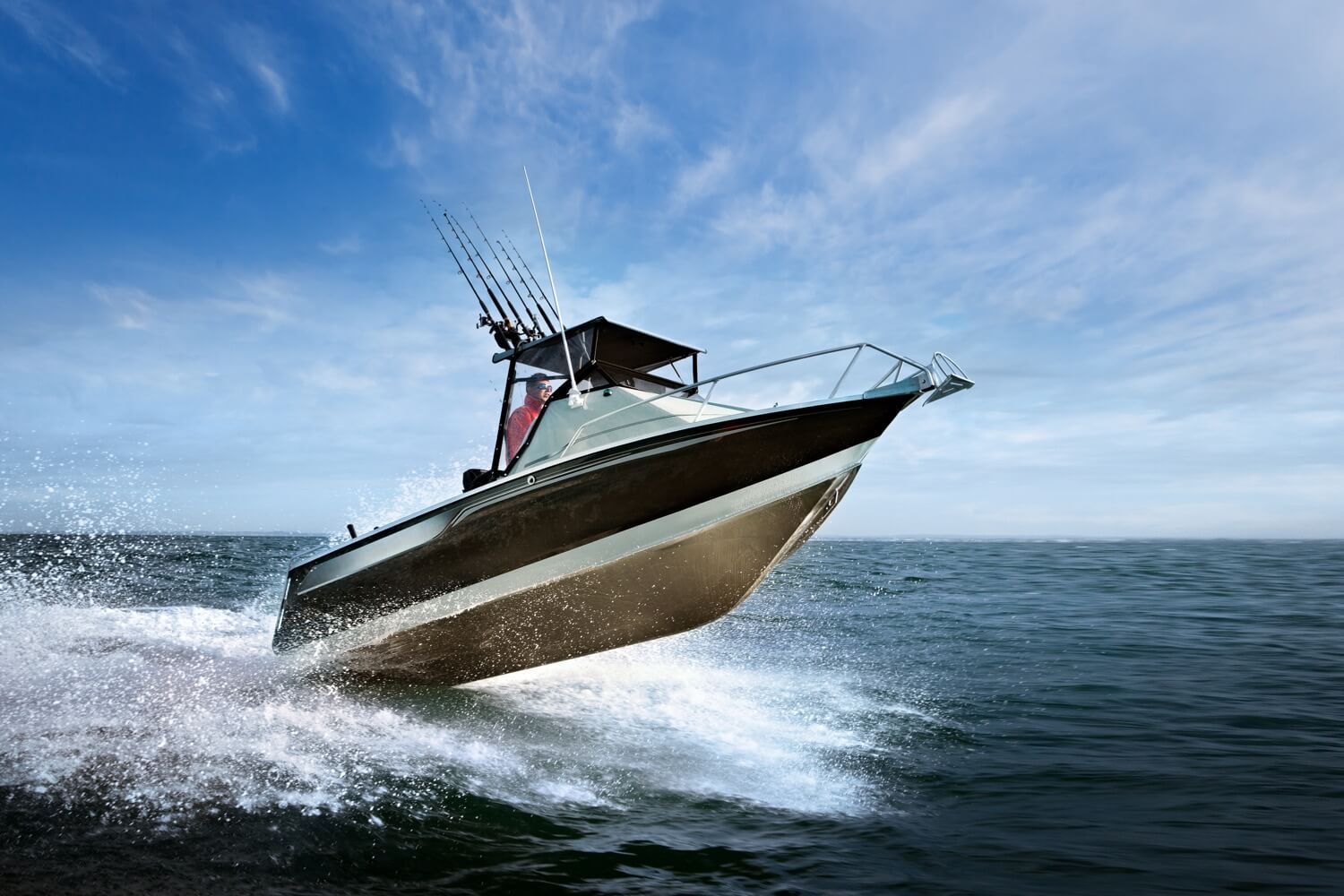
This is a type of planing hull that combines the best of both worlds.
These types of hulls are very popular on modern-day powerboats, and no wonder. With a V-shape that runs from bow to stern, deep into the water, you can handle this boat even in offshore conditions. It handles a lot better than flat-bottomed hulls, while it's at the same time extremely fast.
Examples: Most modern powerboats.
The Deep V-shape acts as a tiny keel of sorts, stabilizing the boat and making it more reliable and maneuverable. The rest of the hull acts as a planing hull, giving the boat its fast edge. Even at high speeds, the Deep V will cut into the water, making it more handleable.
The deep-V design is just one of many variants on the V-hull. Below we'll talk over another, the modified V hull.
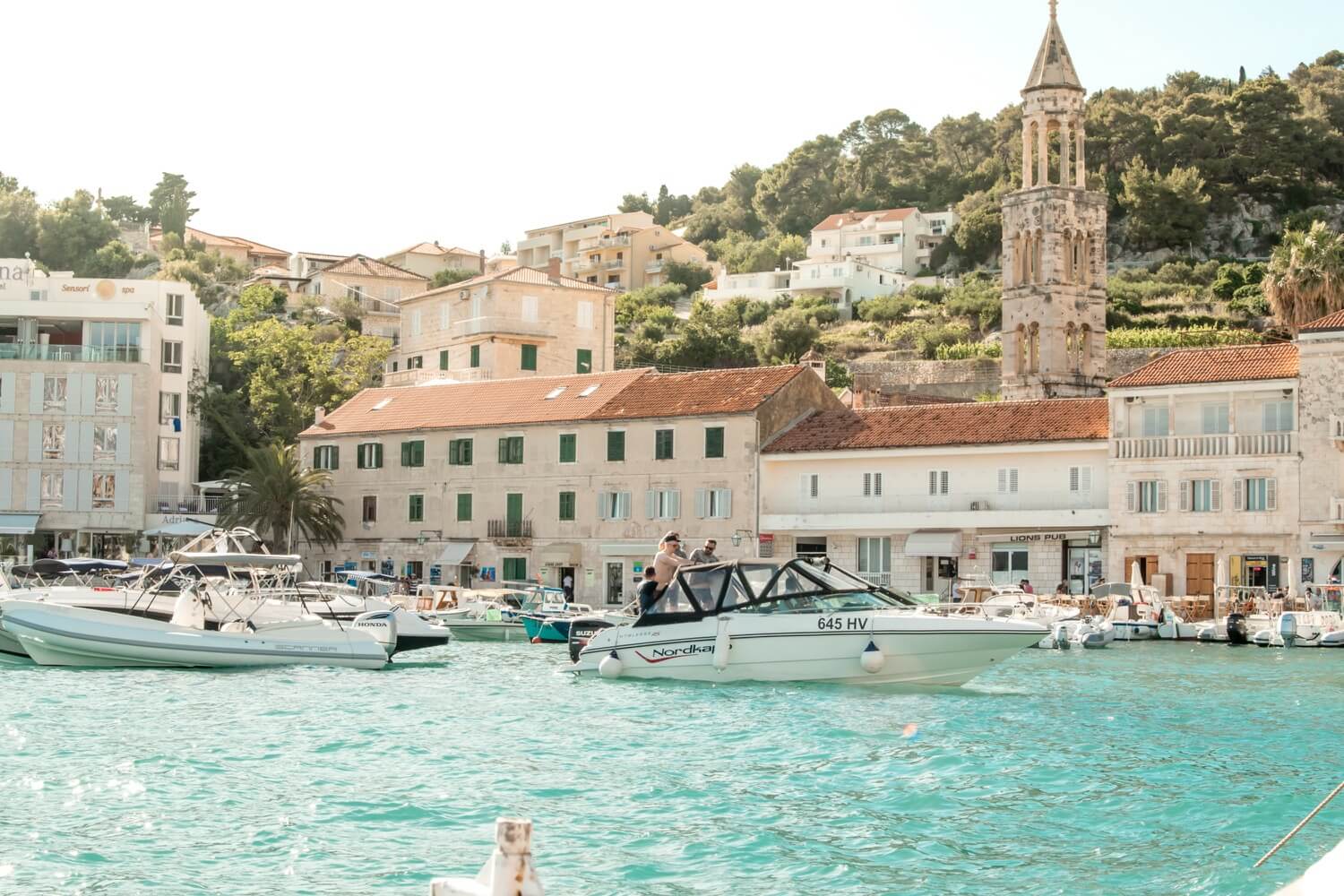
The modified V hull is the ultimate crossover of all planing hull types. It's a mix of the flat-bottom and Deep V hull. It is one of the most popular hull designs for small motorboats. It's flat in the back and then runs into a narrow V-shape to the front. The flat back makes it more stable, and adds a little speed, while the V-shape front ensures good handling.
It is, in short, kind of the compromise-family-sedan of boat hulls. It's the fastest design that's also stable, that's also safe, and that also handles well. But it's not the best in any of those things.
Most powerboats you've seen will have some sort of Vee or Modified-V hull.
Stepped hulls are used on high-performance powerboats. It's a type of planing hull that reduces the hull surface by adding steps, or indents in the hull below the waterline. It looks something like this:
It is said to work extremely well at high speed (60 knots and up) and adds up to 10 knots to your top speed.
On to our next design. There are also planing multihulls, and they might even look like catamarans to you. Meet the pontoon hull.
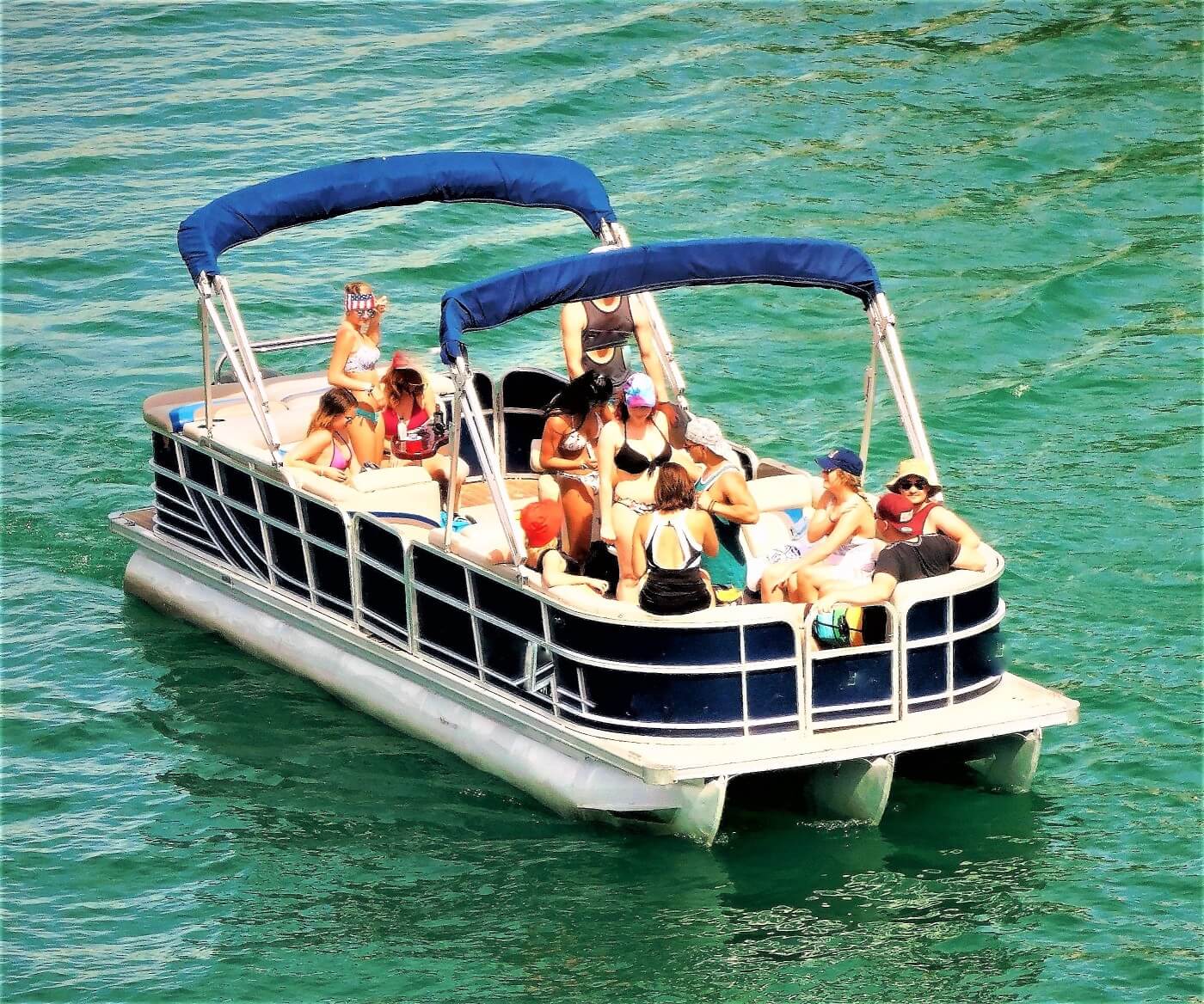
Pontoon hulls float on top of the water using pontoons or floaters that create lift. It's a type of planing multihull that doesn't lie in the water, so it doesn't displace a lot of water. They don't really handle well. As with any multihull, they aren't agile - they're not great at maneuvering. They also have a very large turning radius. But they are extremely stable: there's no chance you'll capsize this.
Examples: Cruisers, modern trawlers, motor yachts, Maine lobster boats
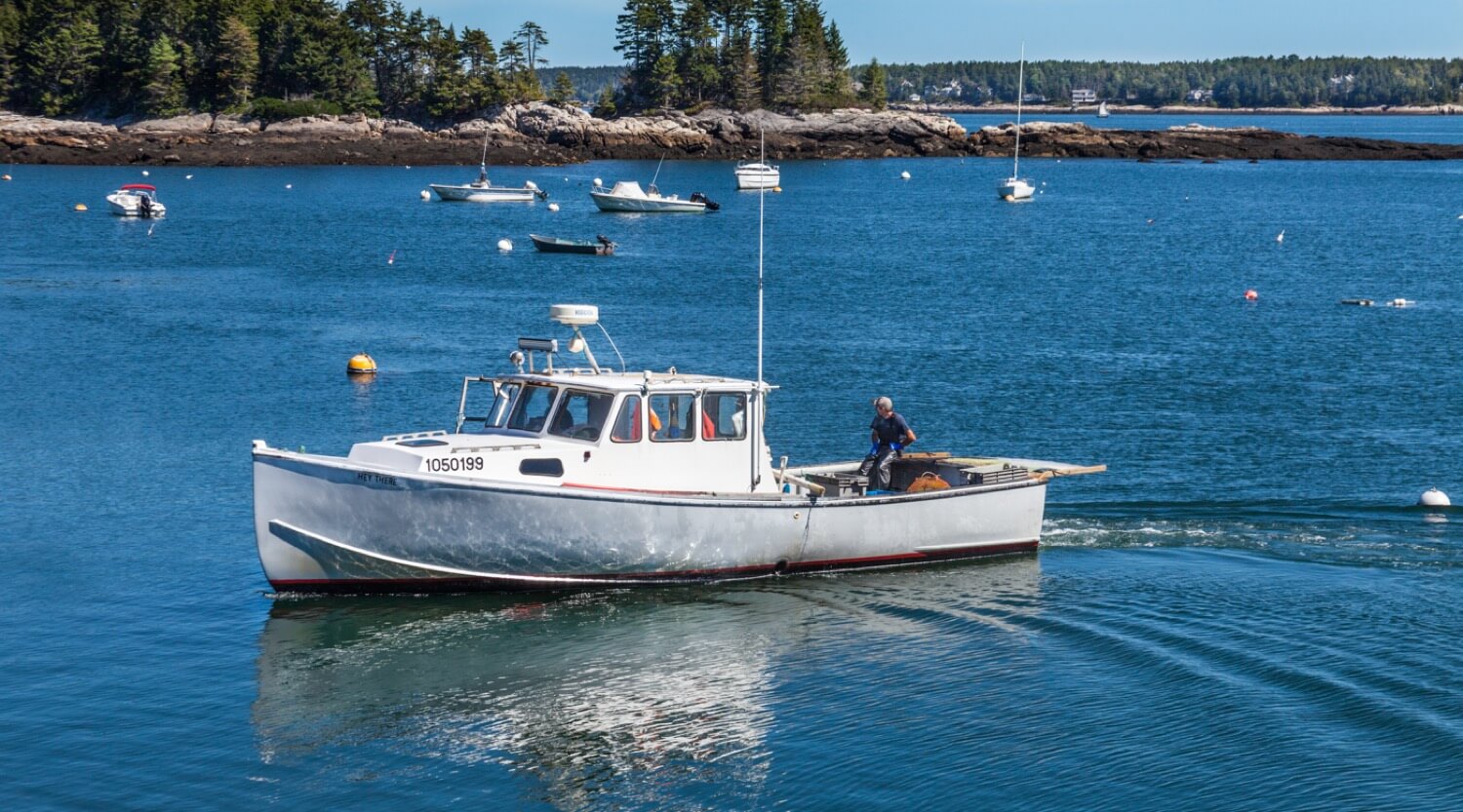
Semi-displacement hulls are smack bang in the center of planning and displacement hulls. They are a bit better for speed than displacement hulls are. They are a bit better for handling rough waters than planing hulls are. This makes them very versatile.
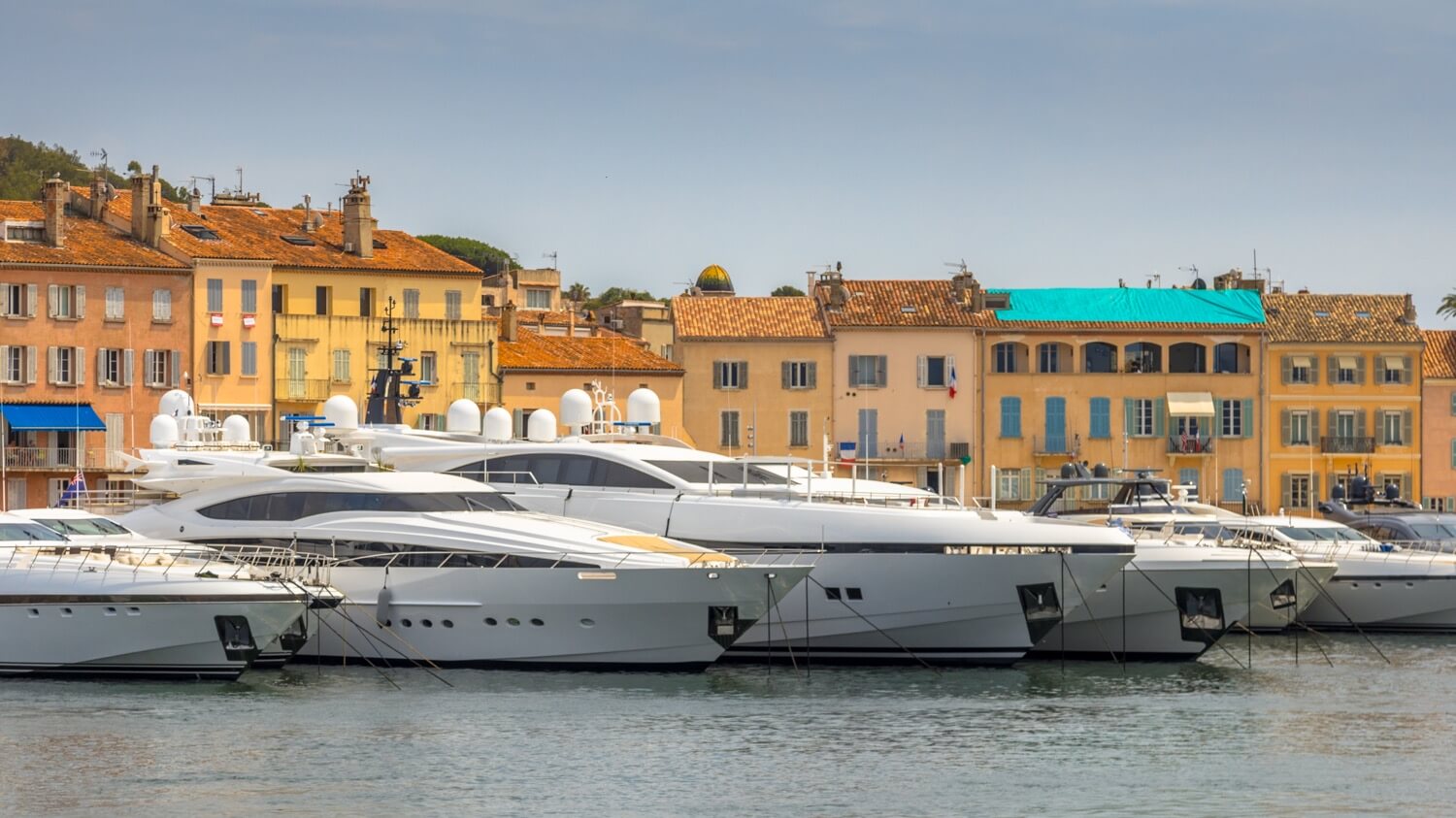
You can see these a bit like being 'half-planing' hulls. These hulls are designed to plane at lower speeds than normal planing hulls - somewhere in the range of 15 - 20 knots, depending on the length of the boat. It also requires less power. When the hull lifts, it reduces drag (water resistance), making it faster and more efficient.
Semi-displacement hulls are perfect for boats that need to be steady and seaworthy but fast at the same time.
For more information about semi-displacement hulls, please check out my in-depth guide to semi-displacement hulls here . It has a diagram and lists all the pros and cons.
So those were my 11 examples, and my step by step explanation of the different types of boat hulls and functions. You now have a solid basic understanding of boat hulls, and can recognize the most common ones. I hope it was helpful, and if you want more good sailing information, be sure to check out my other articles below.
https://www.soundingsonline.com/boats/how-different-hull-types-react-in-rough-water . ↩
I was wondering what your opinion would be on the ship uss Texas as far as hull type and bow type. I think it has a plumb bow and it looks to have a displacement or flat bottom hull. Im doing some research and a better trained eye would be of great help. I used images “bb-35 dry dock” to help see the hull shape. Thank you
Shawn Buckles
Hi Kirk, I don’t know about trained but here we go. I’ve checked the picture, it’s definitely a displacement hull I’d also say it’s a plumb bow.
Hahahahaa imagine liking boats hehehehehe Extremely stable & faster Handles well in rough water Extremely stable & faster Handles well in rough water Extremely stable & faster Handles well in rough water Extremely stable & faster Handles well in rough water Extremely stable & faster Handles well in rough water Extremely stable & faster Handles well in rough water Extremely stable & faster Handles well in rough water Extremely stable & faster Handles well in rough water Extremely stable & faster Handles well in rough water
Leave a comment
You may also like, a complete guide to displacement hulls (illustrated).
The displacement hull is the classic go-to hull design for sailboats and one of the most recognizable ones out there. In this guide, I explain all there is to know …
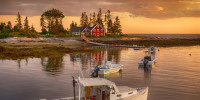
Semi-Displacement Hulls Explained (Illustrated Guide)

The Ultimate Guide to Sail Types and Rigs (with Pictures)
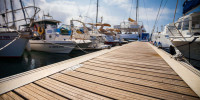

How Much Does it Cost to Dock a Boat for a Year?
Own your first boat within a year on any budget.
A sailboat doesn't have to be expensive if you know what you're doing. If you want to learn how to make your sailing dream reality within a year, leave your email and I'll send you free updates . I don't like spam - I will only send helpful content.
Ready to Own Your First Boat?
Just tell us the best email address to send your tips to:

The 8 Main Characteristics of a Catamaran Hull
Posted on May 28, 2022
Ever wonder why your catamaran ride is so much smoother than other boats, including yachts? Why don’t I get as oozy as when I’m on other vessels, even when the water is choppy?
It’s all about the hull, my fellow water enthusiasts. Not just one but two hulls, positioned in such a way as to give us the most perfect ride we can get on the ocean, without us having to grow fins.
Catamarans have a wide beam, instead of a ballasted keel like a monohull vessel, which provides its steadiness. It has a more shallow draft and smaller displacement than a monohull with a similar length. Its hull offers stability, more space, privacy, no heeling, lower hydrodynamic resistance, and more.
Now that you’ve gotten the gist of it, let’s look in-depth at the hull characteristics.

1. Lower Hydrodynamic Resistance
Hydrodynamic resistance of the combined two hulls is usually lower than equivalent monohulls, needing less power from the sails or the engines. A catamaran’s broader posture on the water can decrease the feeling.
It also lessens the motions caused by waves, which can also produce smaller wakes than on a single-hulled vessel.
A cat’s hulls have a less wetted surface area, which means they burn less fuel. The boat may be propelled by one engine in mild winds.
2. Reduced Heeling

The term “heeling” refers to the tendency of a sailboat to lean to one side due to the force of the wind on its sails. The boat is oriented so that the wind hits the sails at an angle and pushes them to one side of the boat, propelling the boat.
Catamarans are the safest way to navigate the oceans because they have no heel angle. Cruising catamarans are safer than monohulls for their crew because they offer better protection and a no-heel environment.
As a result, the crew will be less exposed, make fewer mistakes due to exhaustion, and arrive at their destination more rested.
3. Less Displacement
Boats that employ buoyancy to support their weight are referred to as displacement hulls. To provide its name, it is partially immersed and moves by causing water to be dislodged.
Its weight is equal to the amount of water it dispenses. In stormy water, it maintains its sturdiness. As a result, cruisers and sailboats alike frequently make use of this design.
4. Stability

In place to evade capsizing as well as heeling, the catamaran depends on hull stability, while hull stability depends on buoyancy and beam. About half of a typical cruising catamaran’s length is its beam.
Say, for example, that the boat was 50 feet in length, the beam might be about 25 feet broad so that you could maintain the balance between heel and righting moment.
On a cat, passengers who are prone to motion sickness will be far less affected by the impacts of motion than they would be on a monohull. The cook’s task is made much easier while traveling and at anchor because of the cat’s extra stability. When compared to monohulls, catamarans have less rock and roll.
Once you’ve decided to sail, you won’t have to worry about scrambling to stow things or securing them with bungee cords. Relatively rough seas have little effect on most of the ship’s equipment.
5. A Bridgedeck Connects Them

You can’t ignore this reality! Bridgedeck clearance, or the gap between the water and the bridge deck, is an important factor in a catamaran’s safety and reliability. Ocean waves have room to flow between the hulls thanks to the bridge deck clearance.
Our catamaran’s hulls create waves that converge underneath the bridge deck, requiring a larger buffer for the bridge.
If you don’t have enough clearance, your catamaran will be pounded by the waves.
In addition to slowing your catamaran down by 3 to 4 knots, rough seas can also put your guests’ health and safety at risk, as well as inflict significant damage to your boat and rigging.
6. Can Maneuver Shallow Water
A boat’s draft is the distance from the water’s edge to the hull’s center of gravity. It is important to know the depth of a boat’s draft since it determines the quantity of water that can be displaced for safe passage. As a result of their parallel hulls’ buoyancy, catamaran vessels can have fewer drafts without affecting their stability or their ability to maneuver.
When it comes to hull stability and handling, monohull vessels are built with a deeper draft to protect against capsizing as well as heeling. Because of this, the catamaran was deemed suitable for use in shallow waters.
Boating activities such as swimming and fishing aren’t the only ones that benefit from being able to dock in shallow water. A boat with a shallow draft will be more maneuverable in areas where you may have to sail through a variety of shallow areas, some more than others.
Monohull boats with deeper drafts may be unable to access shores, intertidal zones, coral reefs, or even sandbars because of their shallower depths. Also, shallow-water swimming and snorkeling are two of the most popular pastimes for sailors plus their families. To ensure a smooth experience, you’ll need secure access to shallow waters.
There are several types of fishing that require a catamaran’s dependability and readiness, and these include trout, oystering, and clamming. These activities become much easier when you can navigate shallow waters without worrying about running aground or striking underwater objects.
7. Allows Cat to Have More Space
It certainly does. Eating and preparing food can be done side by side. One hull is used as a big cabin in the “owner versions,” which are fantastic for parties.
Most comparable-priced monohulls lack the amount of interior room seen on catamarans, especially in the primary salon, galley, plus cockpit. As a result, their cabins tend to be larger, and now even the tiniest cat in the group has a stand-up headroom in each one.
8. Offer More Privacy
The distance between the two hulls allows for greater privacy than on monohull yachts, which tend to be closer together.
Because of the configuration, a cat offers more solitude than monohulls, and the increased separation between the main living area and the cabins makes it simpler for children to go off to sleep at a normal hour when aboard.
What Are the Differences Between Catamaran and Monohull Sailing?

Most characteristics of sailing a catamaran resemble those of sailing a monohull. In most Catamaran Sailing Boats, the abilities you acquire on a monohull, you can transfer to a cat. A few minor distinctions must be made though, including these.
Keep a steady speed during the tack to avoid “winning,” which can occur if you relax the mainsheet too much. Winning occurs when a catamaran’s larger mainsail tries to direct the boat towards the direction of the wind.
Gybing on the monohull necessitates much more caution, therefore you have to slow down your gybe considerably. Travelers on catamaran boats have an advantage since they can sustain a pace while gybing to depower the main.
You can tell when you’ve got too much sail on a monohull by the way the boat is heeling, which tells you it’s time to reef. Since catamarans don’t heel, we have to be super cautious when reefing the enormous mainsail because it’s so heavy.
In most cases, the first reef will be thrown in between wind speeds of 18 and 20 knots (determined by the size of our yacht) and the second reef will be thrown in as the wind speeds reach up to 25 knots.
Many elements of sailing a catamaran are fairly similar to those of a monohull, so making the switch should not be too difficult.
Are Catamarans Safer Than Monohulls?

Exactly what I was looking for! People are less likely to drown when sailing on a catamaran than on a monohull, thanks to the boat’s greater stability. They are bigger, more steady vessels. In most cases, this makes cats “safer” than a monohull of the same size.
Having two engines makes catamarans “safer” in the event of an engine breakdown. Sailing is the sole alternative on a monohull boat if the motor is out of commission. In the event of an emergency, the second engine on a catamaran is always ready to assist!
Is Sailing A Catamaran Easier Than Sailing A Monohull?
It is more difficult to sail a monohull because of heeling and the constrained space it has to offer. In greater gusts, monohulls heel, making it harder to accomplish most activities.
Sailing aboard a heeling vessel is more difficult for a variety of reasons, including heading forward to a reef, having to haul in a sail, or just moving around the boat.
The greater stability and space provided by catamarans, on the other hand, make moving around the boat easier than on other types of boats. The fact that catamarans are typically referred to as “easier” to sail is due to this.
- 2024 BOAT BUYERS GUIDE
- MIAMI BOAT SHOW
- Email Newsletters
- Fishing Boat Reviews
- Fly Fishing
- Marine Electronics
- Fishing Tackle
- Best Marine Electronics & Technology
- Fishing Destinations
- The Bahamas Fishing Guide
- Boating Safety

2023 Boat Buyers Guide: Catamarans
- By Karl Anderson
- December 27, 2022
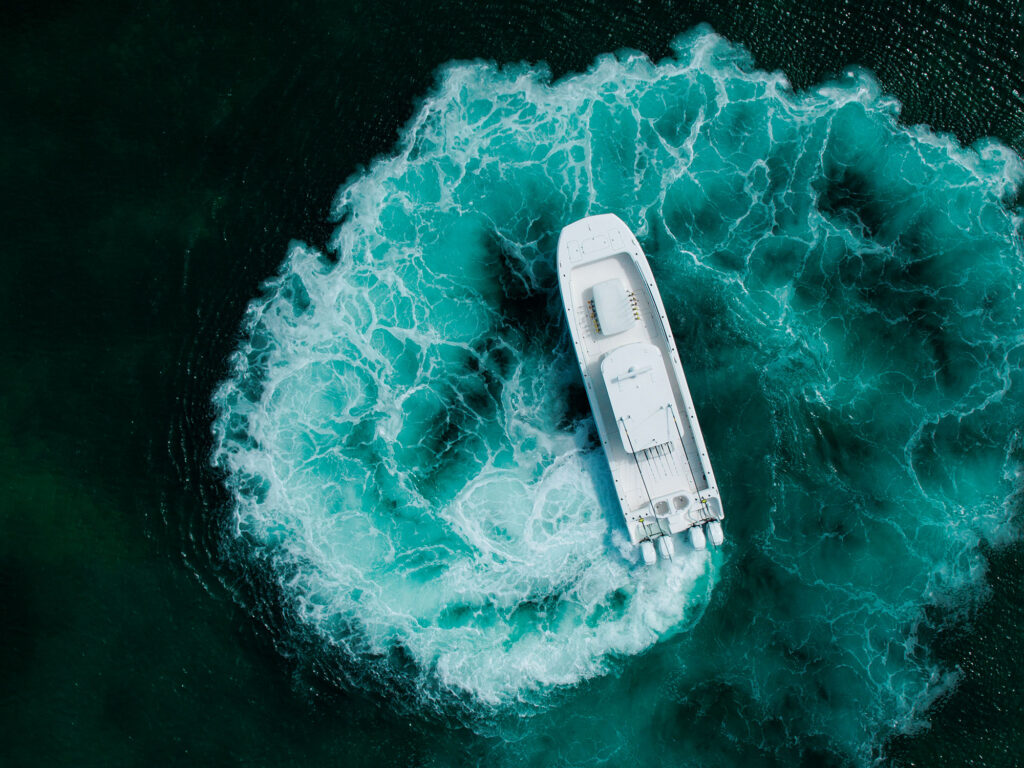
The popularity of the multihull (aka catamaran or cat) fishing boats has never been greater, as more and more boatbuilders enter this growing segment of the market. The inherent stability of the catamaran design rolls less with the seas, making fishing offshore less tiresome and more comfortable. Available from 20 to 48 feet, catamarans typically offer a large fishing platform with generous storage and fishing amenities. They are available in a wide variety of deck layouts, including center-consoles, dual-consoles, and even pilothouse and express variants.
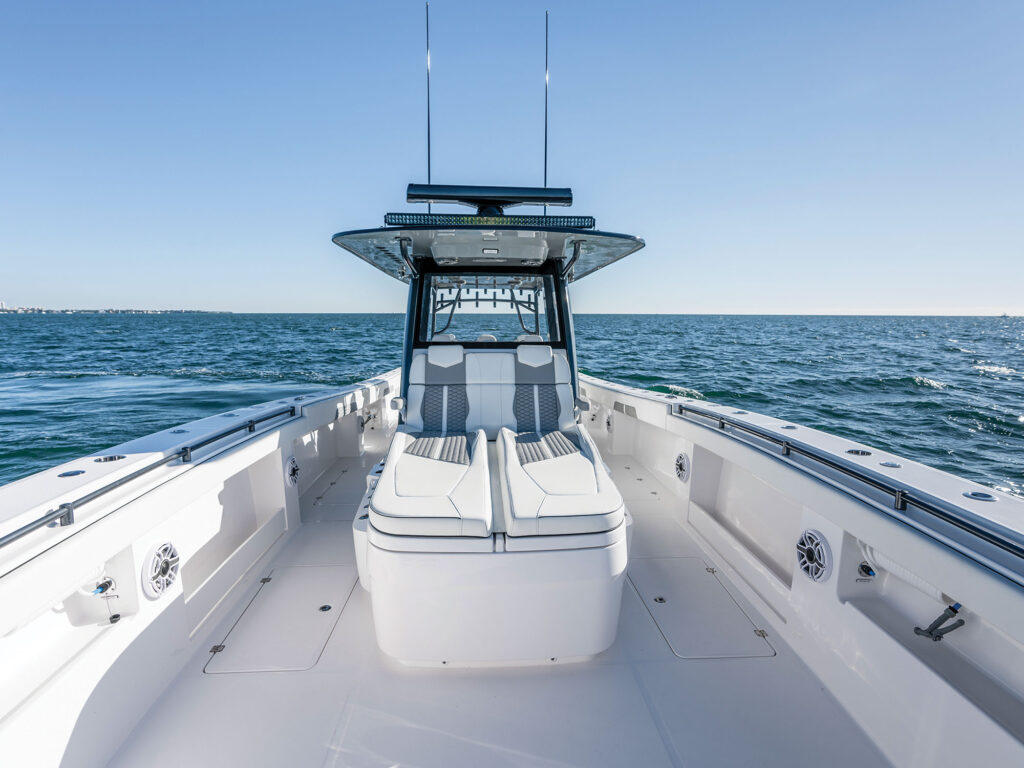
Big Picture
The large deck area of a catamaran enables many large underdeck storage lockers and insulated fish boxes in the sponsons. This gives anglers ample room for gear and the day’s catch. The catamaran’s stability, fishability, and smooth ride in rough seas make it attractive to anglers as well as day-cruisers. A center-console version adds 360 degrees of angler access to the rail. With the dual-console design, generous seating behind a beam-to-beam windshield makes for a great family fishing-friendly setup.
Live bait is one of the most popular types of fishing in virtually every coastal zone. To do it successfully requires optimal water capacity and proper flow. The minimum size of the outflow water plumbing should be twice the size of the inflow. The plumbing should have a drain at the bottom to shed scales at the end of the day, as well as a drain at the top of the well to adjust capacity and allow overflow. Above-deck transom-mounted wells should fully flood to the lids when running to keep baits from getting beat up.
Tip: A sump box with multiple pumps in case a pump fails is the best setup for first-rate livewells. Conveniently located inflow and outflow valves make it easy to optimize the flow without tiring your bait from swimming too much in the well.
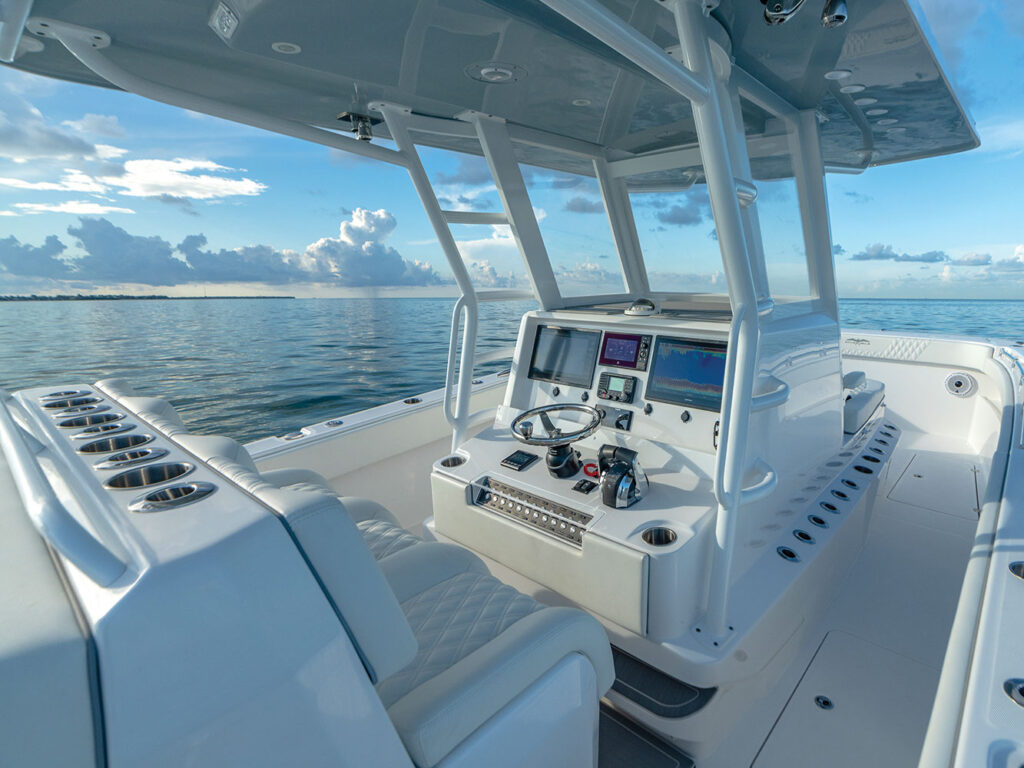
Rod Storage
Having enough rod holders is essential to be successful for opportunity fishing. Look for vertical rod storage along the console and across the back of the T-top. Many models also have rod holders along the outboard transom wall. Having plenty of gunwale rod holders for drift- and kite-fishing is helpful.
Tip: Placing adjustable swivel rod holders by Gemlux makes deep-dropping, lure-fishing and drifting even easier because they allow your rods to face the direction the baits are fishing, yet they can be swiveled back to keep rods from sticking out of the boat while running and docking.
Manufacturers often offer multiple choices for horsepower, but whatever the choice, the engines must come in pairs. For example, you might order twin outboards (one for each sponson) or four outboards (two for each sponson), but single- or triple-outboard configurations are not common on a cat. Optimal selection should be made based on user load, weight of the boat, ride comfort , performance desires, and best case for resale. It’s a rare day when you can run wide open, but having more horsepower gives better torque at slower speeds and thus better control. Running larger engines slower gives better fuel efficiency too.
Tip: When possible, choose the highest horsepower offered because it typically leads to a better resale value with a shorter sales cycle.
Power steering from engine manufacturer Optimus or SeaStar is essential with the higher horsepower required for larger boats, and it makes installing and operating the upper station in a tower far more practical and comfortable.
With the power demands of electronics, livewell pumps, stereo amps and more, it is wise to have at least two house batteries, and for larger boats, a third or fourth with a multibank charger for dockside. Each engine should have its own dedicated battery as well.
Electronics
Typically choosing the largest screen or multiple screens that will fit on the console is best-case scenario for ease of use, ergonomics, and visibility. VHF radios, stereo controller, and equipment switches for lighting, pumps, and accessories should all be integrated with greatest visibility and ease of operator reach.
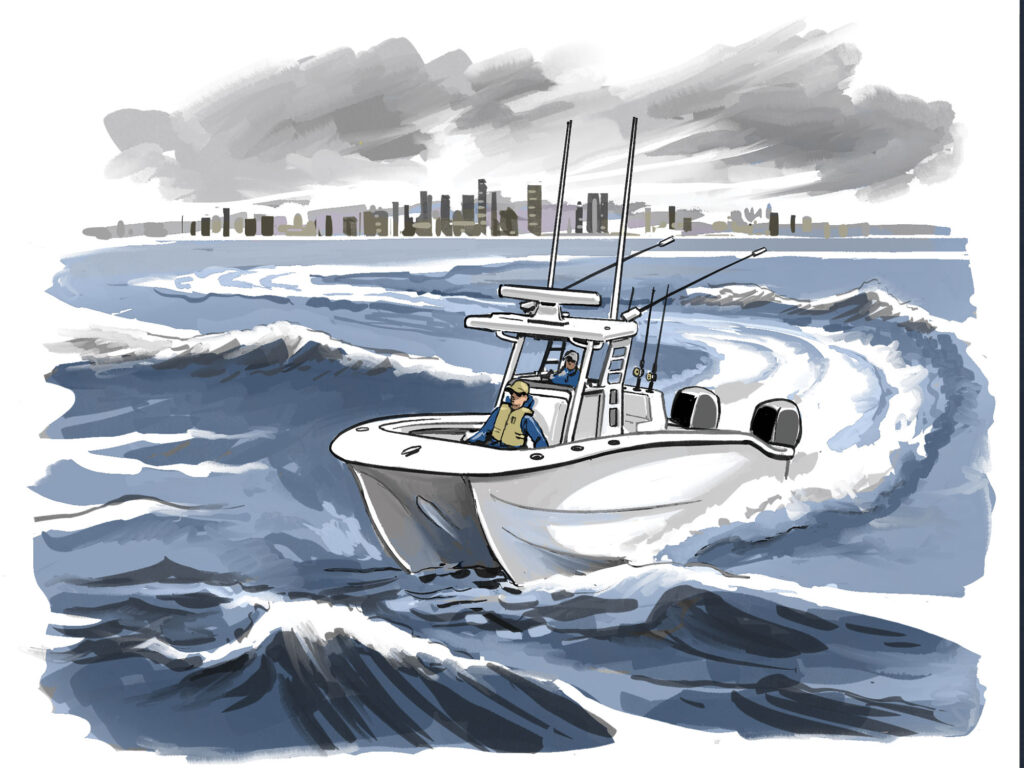
A Tale of Two Hulls
A catamaran rides on pair of hulls, or sponsons, each thinner and sharper than that of a similarly sized monohull boat. The narrow sponsons of the cat tend to slice easily through water to deliver a smooth ride, even in rough seas. At the same time, with the sponsons positioned out to the sides of the boat, cats tend to roll less, thus providing great stability to enhance crew comfort, security and safety. However, cats tend to corner more flatly than a monohull, and some hulls (but not all) tend to lean outward versus inward during a turn.
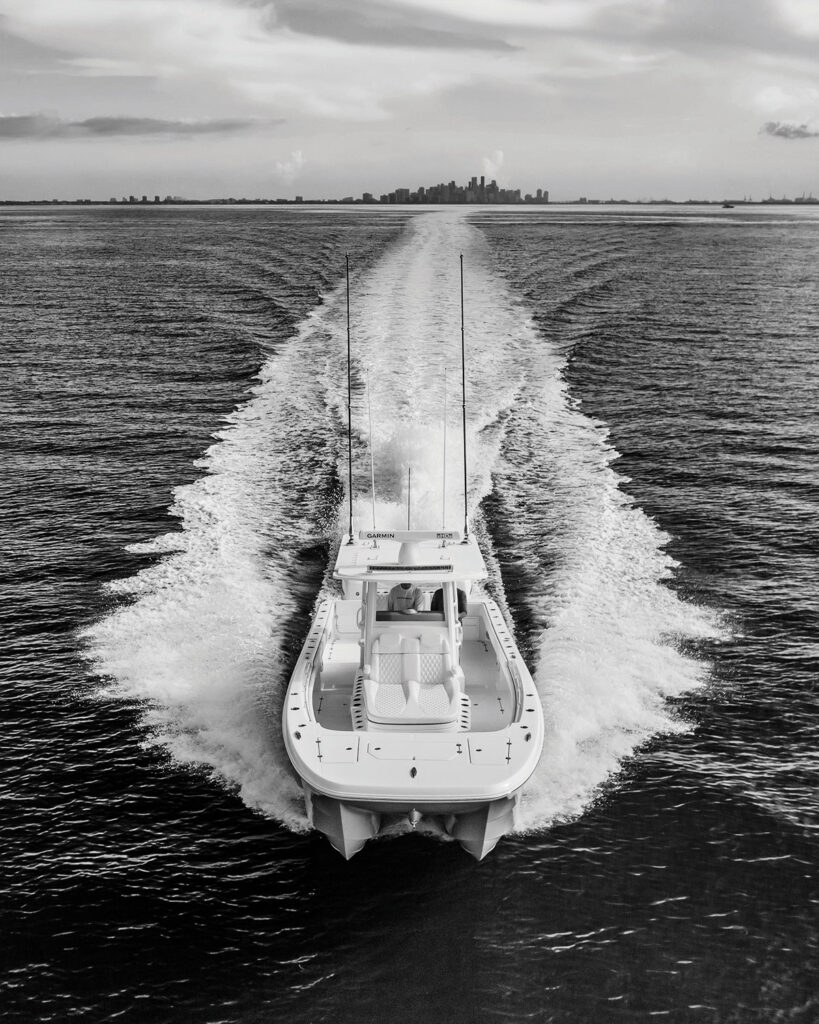
Experts Say
Newer designs such as Invincible’s Morelli and Melvin-designed semi-asymmetrical sponsons eliminate some of the negatives of the cat design, such as “sneezing,” where water sprays out the front of the boat when hitting a wave. They’ve also controlled the uncomfortable “outboard lean” sensation common in older designs when in a turn. Once transitioned to a catamaran, many become true believers and preach the benefits of the design.
Editor Says: Saltwater fishing cats not only offer superb stability and smooth ride, but some also display exceptional speed and range. I recall one trip out of Key West, Florida, aboard an Invincible 40 Cat with four 350 hp outboards to the Dry Tortugas. It was a 60-mile run, and we made it there in 70 minutes. We caught more fish than our arms could bear, and then dashed back to Key West, arriving in time for cocktail hour on the same day. -Jim Hendricks, Staff Editor, Boating and Fishing Group
- More: 2023 Boat Buyers Guide: More Resources , Boats
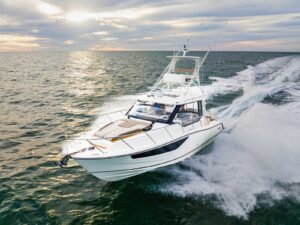
Salt Water Sportsman On Board: Boston Whaler 365 Conquest
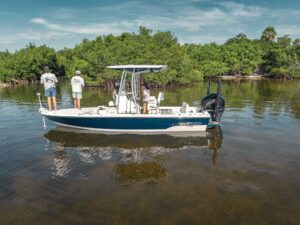
Pathfinder 2200 TRS
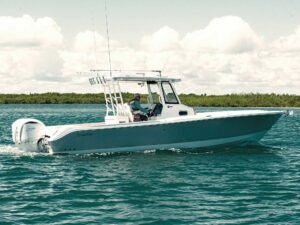
EdgeWater 325CC
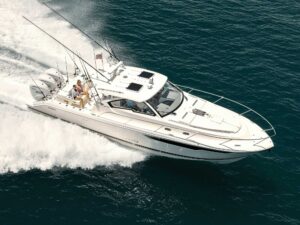
Pursuit OS 405 Offshore
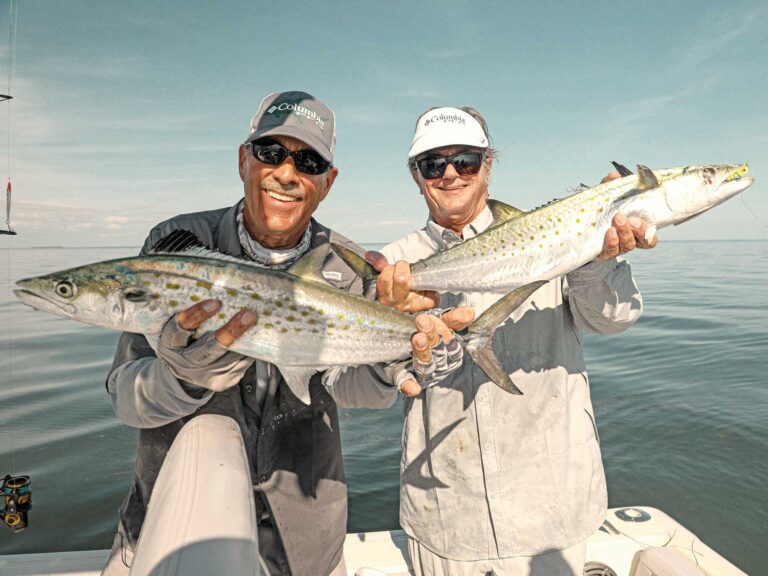
Top Spanish Mackerel Fishing Tips
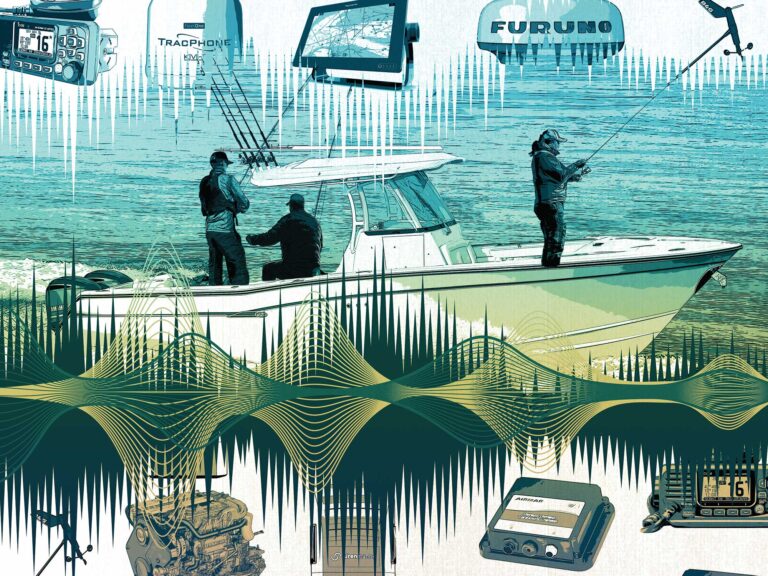
What Can Boating Anglers Expect From NMEA OneNet?
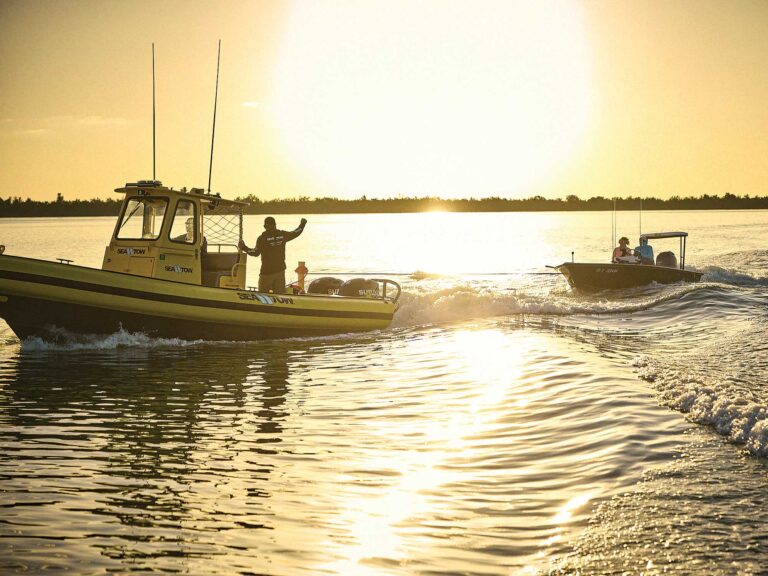
10 Common Solutions for Boat Engine Problems
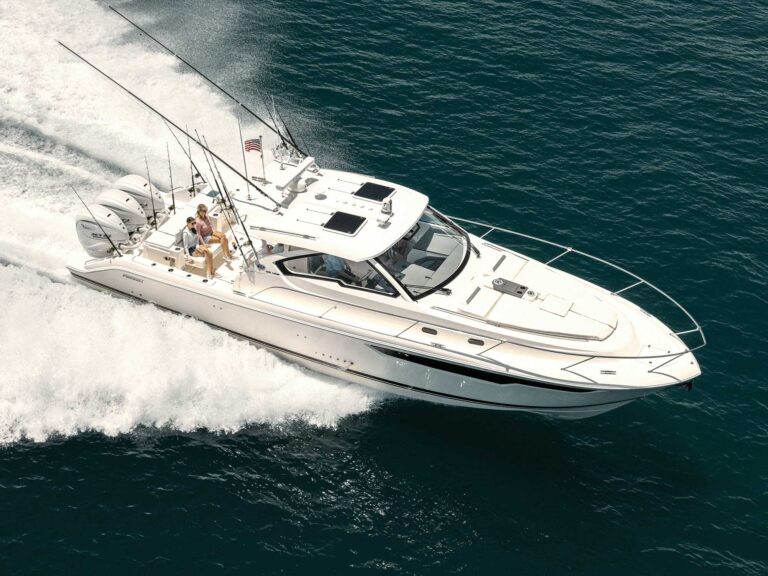
- Digital Edition
- Customer Service
- Privacy Policy
- Cruising World
- Sailing World
- Salt Water Sportsman
- Sport Fishing
- Wakeboarding
- Paddle Board

A Guide to Power Catamaran Boats
If you’re into offshore fishing or water sports, the Power Catamaran or “multi-hull powerboat” offers you a great option for your first vessel. These powerboats provide you an excellent combination of performance, stability, and maneuverability.
These boats have a catamaran design, relying on two hulls to float the vessel instead of the typical deep-V hull found on other powerboat models. The multi-hull powerboat is ideal for cruising, and you can set it up for fishing or watersports as well.
With the multi-hull powerboat, you get options for multiple fishing stations over each hull without disrupting the boat’s balance on the water. They are ideal for use in lakes and estuaries, and they excel on the open ocean.
These boats come in lengths ranging from 16 to 30-feet, with plenty of customizable options and accessories. Typically, you get a stern-drive or outboard motor configuration, with center consoles for the driver and loads of storage space onboard.
These boats can carry from six to eight passengers easily, and most models will fit on trailers. This post gives you all the information you need on selecting the right multi-hull powerboat to suit your aquatic needs.
What Is a Multi-Hull Powerboat?
The multi-hull powerboat features a catamaran design, with two hulls running down the boat’s length, featuring a gap between the two. This configuration makes the boat exceptionally stable at higher speeds, allowing fast movement through choppy water inshore or offshore.
The catamaran might seem like a niche boat design. However, it offers you several advantages on the water, such as a smooth ride, stability, and economy. These boats come in a wide range of designs and lengths, with the smallest versions measuring around 12-feet, and the largest extending up to 70-feet or longer.
The longer vessels come with liveaboard facilities and all the amenities you need to spend days out on the water. We like to think of the multi-hull powerboat as the catamaran design of the cabin cruiser or cuddy cabin boat. You get all the same advantages as these models but with an added performance on the water.

You get plenty of options for live wells, rod holders, gear storage, and integrated coolers for drinks and fish. Whether you’re planning a weekend trip or just going out for the day, the multi-hull powerboat is a great choice for your ocean-going excursion.
While the catamaran model is the most popular choice in this category, there are models featuring a tri-hull design. Typically, these vessels cater more towards fishing than performance or watersports, offering slightly less steering maneuverability than the dual hull setup. However, the addition of the third hull brings superior stability to the boat, making them ideal for fishing in choppy water or cruising from island to island on rougher seas.
The ripple hull models typically feature more liveaboard space, with some models having multiple separate living areas beneath the deck.
Benefits of Multi-Hull Powerboats
The Multi-hull powerboat offers you plenty of advantages for fishing, cruising, and watersports. Here are our top reasons for adding this boat to your shortlist of considerations.
Speed and Handling
The multi-hull boat relies on two separate hulls contacting the water. As a result, there is less drag from the hull when cutting through the water. You get faster speeds than you do with a mono-hull design and excellent handling with tight turning circles. These boats do well on open water, allowing for superior stability in rough waters when fishing offshore.
Dynamic Cruising
The multi-hull powerboat features dynamic cruising capability. These boats are most popular with recreational users that want to cruise down the coastline on the weekend or take a few days out on the water for a fishing trip. The built-in accommodations in many designs make it suitable for staying out on the water overnight.
Stability and Performance
Multi-hull powerboats can come with several engine configurations. The motors on these boats offer excellent performance, propelling the watercraft up to speeds of 50 to 80-mph, depending on the model. They also make suitable watersports boats, allowing for skiing and wakeboarding.
Plenty of Storage
The multi-hull boat offers you more storage capability than mono-hull models. You get loads of storage room above and below deck for your dive gear or fishing equipment. There is under-seat storage, and the v-berths in the bow of these models can include plenty of amenities.

Center Console Design
The center console driver configuration is common with the multi-hull performance boat. This driver position gives you more control over the vessel when turning. Some consoles may position closer to the bow or aft of the boat, depending on the length and design features of the boat.
Hardtop Designs
Most multi-hull powerboats come equipped for long ocean-going trips. As a result, they may have a covered driver cockpit leading to below deck accommodations or storage facilities. Some models have wraparound cockpits with doors sealing the cabin, allowing for air conditioning inside the boat on hot days. Other models come with an open plan design and a hard roof.
Trailerable
Most models of multi-hull power bats range from 16 to 24-feet, but there are plenty of longer models. The shorter lengths are easy to trailer, allowing for easy removal for the water and transportation. However, some models may be wider than 10-feet, requiring a special license to operate the loaded trailer. Check with your local authorities for trailer regulations and laws.
Fishing and Watersports Capability
These boats are excellent fishing vessels, offering you plenty of stability for casting on any side of the boat. The center console design means you have walkways on either side of the console, allowing the angler to chase the fish around the boat if it decides to drag the line. Most models also feature setups for watersports like wakeboarding, with T-tower bars or Bimini tops for higher tow points.
Outboard or Stern Motors
The multi-hull powerboat comes with a design for performance out on the water. As a result, these boats usually feature outboard motors with capacities ranging from 150-HP to 450-HP. Some models may use dual-motor setups or stern-mounted motors that hide out of sight.
Multiple Sizing Options
As mentioned, the multi-hull boat comes in a variety of lengths to suit your requirements. Whether you need a large boat for spending days out on the water or a simple day fishing vessel, there’s a multi-hull design to suit your requirements.
Disadvantages of Multi-Hull Powerboats
While the multi-hull powerboat is a flexible design suited for cruising, fishing, or water sports, it does come with a few drawbacks.
Large Engines and More Fuel
These boats feature design and construction for speed, with large outboard motors. As a result, they are somewhat heavy on fuel, especially with a large-capacity dual-motor setup.
Top Multi-Hull Powerboat Models
You have plenty of choices when selecting your multi-hull powerboat. Here are some of our top picks for the best models available.
Calcutta 480
This multi-hull powerboat has a 51-foot length, and it’s ideal for offshore use, providing exceptional stability thanks to the size and the 17-foot beam. It’s one of the largest models available, featuring world-class multi-hull design.
You get a spacious deck with a center console configuration and enough room to walk down either side of the boat when fishing. The dual hull provides exceptional stability combined with the long length, and you get options for diesel-powered or gasoline engines in outboard or in-stern setup to suit your requirements.

The Calcutta brand custom-builds boats for its clients. You get options for fully enclosed bow areas and fishing-style cabins with a roomy helm deck and a sleeping berth included in the bow. You also have an enclosed head for ablutions, but there is no option for a shower.
This model comes with an enclosed cockpit and air conditioning to keep you cool when cruising. The motors on this boat are monsters, featuring a twin setup of 550-HP Cummins diesel inboards available on the sports version for superior power and speed on the water while maintaining the boat’s maneuverability.
There’s a 600-gallon fuel capacity for the thirsty engines, allowing you to spend days out on the water without running out of fuel.
Insetta 35 IFC Hydrofoil
The Insetta 35 IFC hydrofoil offers you the smooth-sailing benefit of hydrofoils, with premium multi-hull designs. The hydrofoil system generates the lift under the hull, allowing for superior, stable sailing in rough water conditions.
The hydrofoil reduces friction and dragging on the hulls, reducing your fuel consumption by as much as 40% compared to other models with a similar dual hull design. The foil fits between the sponsons, featuring design and construction with stainless steel.
Another interesting design feature with this model is the way the inboard motors have positioning towards each other. This configuration allows for maximum thrust for the propellors on the asymmetrical multi-hull.

The foil and motor setup design also allow for much tighter turns than you get with other multi-hull models, giving you similar performance to what you expect in a mono-hull design.
The boat comes with a large coffin box with 156-gallons of space available and an insulated finish. You get eight rod-holders positioned in the bow and aft of the boat. You also get dual 30-gallon transom live wells and an option for a third below the mezzanine seat.
The Insetta 35 IFC hydrofoil comes with a three-pump sea chest, a folding bait station, and plenty of tackle storage. The boat gets its power and performance from dual Mercury 400 Verados, with the vessel topping out at speeds of 58-mph on open, calm waters.
Invincible 46 Cat
This model is the largest in the Invincible range, and it’s a great choice for offshore fishing. This flagship model comes with a 42-foot length and a center console design for easy driver operation. This multi-hull powerboat relies on a hybrid semi-asymmetrical multi-hull giving it great turning capability and maneuverability out on the open water.

The Invincible 46 Cat features a stepped hull with fast acceleration and plenty of lift. You get a quad engine setup with Mercury 450 Racing outboard motors, and the craft can reach a top-end speed of 78-mph. Other notable features of this boat include a vacuum-infused hull and grid-stringer system for an “invincible” boat that’s virtually unsinkable.
Bali Catspace
If you’re looking for a luxury powercat model, the Bali Catspace Motoryacht is a fantastic – but expensive choice. This model features a design from legendary boat maker Olivier Poncin. This model is a natural cruiser and ideal for the longest ocean-going trips.
The dual hull and high ride height from the water provide exceptional stability for the boat, even in the roughest offshore and coastal waters. The boat comes with a lounge on the deck, and there’s plenty of room around the center console cabin to walk the length of the boat on either side of the vessel. The top level of the boat features the captain’s station and wheelhouse, with luxury living quarters underneath.

You get a huge lounge and a v-berth with sleeping quarters for spending the night out on the water. The cockpit presents the captain with a 360-degree view of the water, and the high riding position gives you a view of the ocean that extends for miles.
The boat comes with all the amenities you need, including tables, a full kitchenette, and luxury sleeping accommodations. There are plenty of entertainment options for TVs and stereo systems down below, with an optional hardtop Bimini.
The Bali Catspace Motoryacht receives its power from a single or dual engine setup featuring 150-HP or 250-HP Yamaha motors.
Wrapping Up
With so much variety available in multi-hull powerboats, you have options for any activity out on the water. These boats are more common in coastal waters, and they make excellent fishing vessels.
Decide on the model that suits your activity, as most have a purpose-built design for fishing, watersports, or cruising. There are plenty of customization options, so make sure you keep a budget in mind as the additions can cost more than 20% of the boat’s initial sticker price, increasing your costs.

John is an experienced journalist and veteran boater. He heads up the content team at BoatingBeast and aims to share his many years experience of the marine world with our readers.
A Complete Guide to Micro Skiffs: All You Need to Know!
A complete guide to narrow boats: all you need to know, a guide to aluminum fishing boats.
Comments are closed.
Type above and press Enter to search. Press Esc to cancel.

17 Best Catamarans for Sailing Around the World
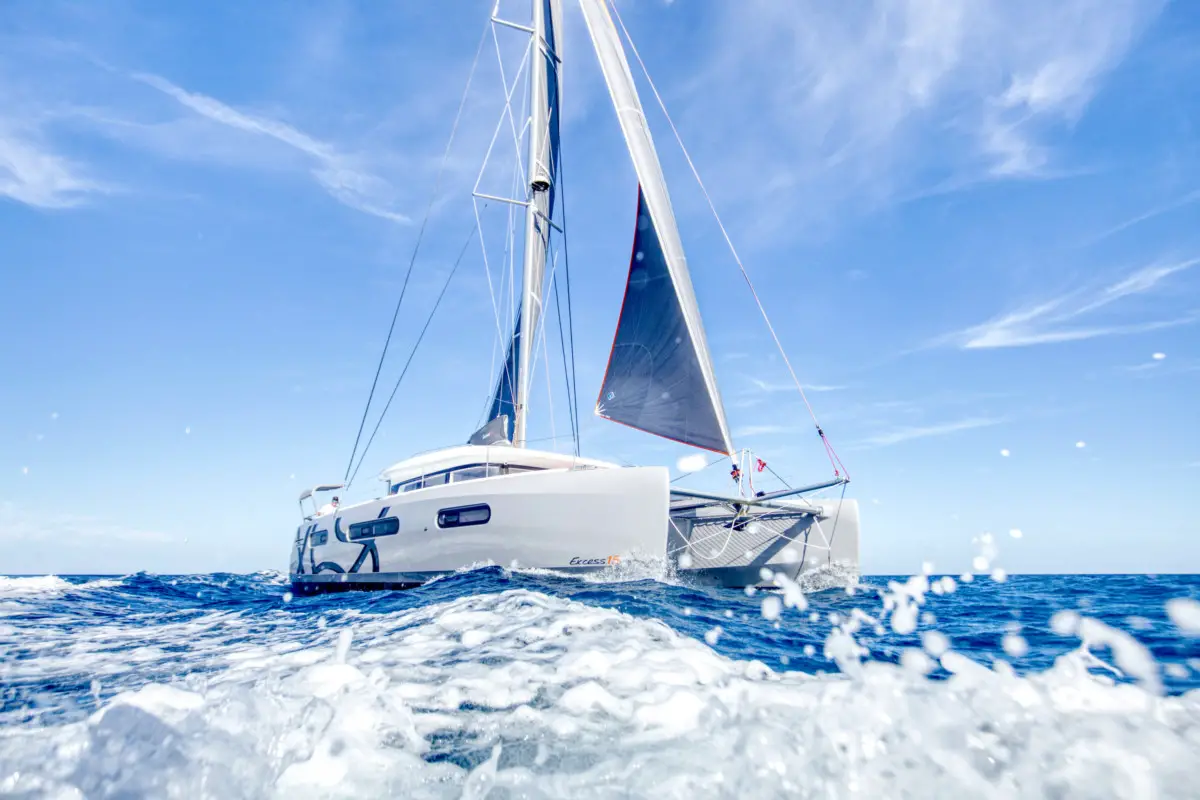
As an Amazon Associate, we earn from qualifying purchases. We may also earn commissions if you purchase products from other retailers after clicking on a link from our site.
Catamarans are quickly outstripping single-hull boats for long-distance journeys. They are more stable and comfortable , and some can travel more than 200 miles in a day. In today’s article, I have put together a complete (well almost) list of some of the best catamarans for circumnavigating the planet; the question is, which one is best for you?
The best catamarans for sailing around the world include:
- The Fountaine Pajot Ipanema 58
These cats focus on speed, safety, and comfort for longer journeys.
This article will show you the seventeen best catamarans for long journeys, and why they’re the best. You’ll also learn some great tips on what to look for in a Catamaran and how to save money by buying a used catamaran. Let this list be a jumping-off point for your future research!
Pro-tip; here are the actual costs of maintaining a cat and here are considerations on how to circumnavigate .
Table of Contents
The Best Catamarans for Sailing Around the World
A catamaran is a double-hulled boat with a deck or cabin area in between (bluewater cat definition in this article ). The double hull design means that the boat rocks less, sits higher on the water, uses less fuel to sail, and can be sailed in shallower waters than a single-hulled boat without worrying about grounding.
Catamarans come in a variety of sizes and can be sail-powered or motor-powered and range from single-person sailing boats to family-sized yachts. Every catamaran design is different, and the twin-hull shape offers many ways to customize the layout of a ship.
Each boat on this list is a larger catamaran (+40ft, more on size here ), so if you’re going to sail around the world, you want lots of space for provisions and rest.
Of course, there are tons of technical specs for each of these boats, but I’m going to focus on the overall features of each of these catamarans, what makes them stand out, and why they would each be an excellent choice for a transatlantic journey.
Antares 44i
The Antares 44i is an excellent option for sailing around the world and was explicitly designed for long-distance cruising. It performs well in any weather conditions, can be sailed easily by two people, and you’ll be able to sail long distances and live in comfort.
Although it can be easily sailed by a crew of two I believe that a true bluewater cat should be set up for single-handed sailing, more on that in another article .
This catamaran features a stateroom on each hull and a forward cabin with plenty of storage space. The living and entertainment features include a flatscreen tv and a high-end deck speaker system.
With this model, Antares dedicates itself to high-quality boats with optimal rigging and engine configurations.
Atlantic 42
Atlantic is no longer building this catamaran, but there are usually a few pre-owned boats on the market. You can also get it made custom if you love the design, but be prepared to spend more money on a custom boat (custom boat also gets custom problems ;)).
The Atlantic 42 is slightly smaller than some of the other catamarans on this list but is a seaworthy vessel. 42 ft is what most sailors I interview ( in this article ) said was the smallest cat to safely cross big oceans. It is also a decent size to counter the risk of capsizing (more on that here ).
It has a forward cockpit and pilothouse, which gives the owner a better use of space and makes the boat easier to navigate. With single-handed capability, one person can sail it easily and let the rest of the crew relax.
One of the best-praised aspects of the Atlantic 42 is its galley, more extensive than most 42-footers (12.8-meter) can offer.
One of the few 50 footers (15.24 meters) that can be sailed by just one person (many would of course disagree on this).
The Catana 50 is a catamaran worthy of an overseas journey. Its size adds to its stability on the open waters and its ability to sail straight through the choppy ocean and windy conditions.
The Catana is also incredibly spacious on the inside, with substantial cabins and showers. The biggest downside to the Catana 50 is its price, as it’s much more expensive than most of its competitors.
Catana also holds up well against some of the fastest cruising cats out there, here’s a list of the fastest cruisers if you are interested in that.
However, if you can find a gently-used Catana 50, you can rest assured that this boat will last!
The Dolphin 42 is unique because of the use of daggerboards instead of fixed keels. This upgrade means that the boat has some pretty decent upwind performance while at the same time being faster downwind.
Centerboards and daggerboards offer some interesting downsides compared to mini keels. This is an interesting discussion and I suggest you read another one of my articles if you want to deepen your knowledge a little.
These catamarans are some of the lightest on the market. Not many Dolphins were made, so they are relatively hard to find. However, if you want a small, lightweight boat capable of going great distances, the Dolphin 42 is an excellent choice.
Fountaine Pajot Belize 43
The Fountaine Pajot Belize is another well-built cruising yacht. Its core is made of foam instead of balsa, which reduces the risk of structural damage due to a rotten core in case of water intrusion.
The design of Belize offers many options for customizability, with large open spaces and a combined saloon, navigation, and dinette area.
There are two styles of Belize catamarans for sleeping quarters. You can either purchase a boat with an entire primary suite on one hull or one with two cabins in each hull. The first option is great if you are sailing the world alone and not expecting many guests, as it increases the storage capacity.
Understanding what factors to consider when getting a cat can be hard, there are just so many of them (such as the daggerboard discussion above), I have tried to compile some of the most important in this article .
The boat also has wraparound windows to increase the sense of space in the galley.
Fountaine Pajot Lucia 40
Fountaine Pajot is one of the best sailboat manufacturers existing today, as their boats are well made and highly versatile. The Lucia 40 is no exception – it’s a smaller boat but has a lot of room for moving around and on-board living.
The living area is remarkably spacious on this catamaran for its size.
The galley and lounge easily accommodate 6+people. The Lucia 40 doesn’t disappoint when it comes to sailing either, as the narrow hulls slice through choppy waters with ease.
Most catamarans today are built to withstand rough weather but that doesn’t matter as much if the crew isn’t up for the task, I firmly believe that the most important thing a boat should consist of, is knowledge. Therefore taking online courses ( two free here ) or reading books ( my favorites here ) is imperative.
Gemini 105M
Gemini’s boats have been on the market for years and are solidly built for cruising. This boat is one of the most popular ever made, I personally would consider something different for offshore cruising, but since it has such a good reputation, I felt I had to add it to the list.
If you want to understand why I am hesitant to take this boat around the world, I recommend you read my article: What are trampolines on a catamaran?
The Gunboat 62 is a great catamaran and set the standards for the rest of the impressive Gunboat lineup. It’s sleek and spacious while being robust and capable of transatlantic journeys. You can easily travel the world in a Gunboat 62 with several people and not feel cramped.
The yacht was made for speed and power and remains one of the fastest catamarans on the market, even rivaling the newer Gunboat models. GABO
Although the earlier models of the Gunboat 62 weren’t designed for a lot of cargo, you can still find space for everything you need without compromise.
Lagoon catamarans are known for their reliability and ease of use. If you are considering a catamaran for the first time and are unsure about the technicalities of sailing, a Lagoon boat is a great option.
The Lagoon 380 is probably the smallest cruiser on this list, which makes it better suited for solo or couple sailing.
When I go looking to buy something, whether it be a boat, campervan, or whatever, I create a checklist and classify all the things I want either by NEED or NICE to have.
I believe the Lagoon 380 to be sub-optimal for my NEEDS, even though it does check a lot of NICE boxes, there’s a step-by-step article on the NEED and NICE method here .
There are several cabin options available on the Lagoon 380, but if you’re sailing by yourself, you can settle for three cabins and a larger galley and living space. With a smaller cockpit and broader side decks, the Lagoon 380 packs a lot of practicality and ease of sailing into a more compact catamaran.
If you like the idea of a Lagoon boat but want a little more space, the Lagoon 42 is the upgraded version of the Lagoon 380. With all of the same benefits, it comes with more space for cabins or storage, making it one of the best-selling Lagoons of all time.
The Lagoon 42 is also a faster cruiser built for strength. While it’s not the fastest on the market, it works well in choppy waters and windy conditions, making it great for the beginning sailor to go on a more extended trip.
Many people have completed an around-the-world sail with this ship.
Although there is a flybridge version, I would recommend the “open” version due to several factors, some including increased windage and a higher boom. More on flybridges pros and cons here .
For stability, safety, and durability, you can’t beat the Lagoon 42.
The Leopard 45 performs better with less storage weight because of the relatively low bridge deck clearance. If the boat is fully loaded, you could experience some wave pounding. However, the cockpit is open and airy, with devices that block the sun and provide maximum comfort while sailing.
The Leopard 45 is an incredibly beautiful boat, and has a strong reputation for excellent build quality!
Leopard catamarans are one of my personal favorites, as such I have written an entire article about the brand, so if you want to understand its pros and cons then here is the link . Gabo
Designed in South Africa, it features a high rear arch for extra support and very smoothly connected decks. The galley is large and open, and most Leopards offer a four-cabin plan. If you are traveling with another person, this boat is an excellent option for you!
The Manta 42 is another classic catamaran that you can buy used (at a decent price), as it is an incredibly seaworthy vessel. While still in production, the Manta was one of the most popular catamarans on the market.
It is still in high demand amongst circumnavigators. Buying a used Manta 42 usually means that you inherit some of the previous owner’s boat upgrades!
The Manta 42 also made it to my list of the 9 safest catamarans on the market ( link ).
This blue water cat can be sailed by one or two people, making it ideal for liveaboard couples or long-distance shorthanded sailing. The galley is in the saloon ( instead of in one of the hulls ), making the cabins below more spacious and better equipped.
Overall, the Manta is well equipped for sailing around the world.
Nautitech 44
Nautitech is an excellent brand of the catamaran, with several different designs per boat. The Nautitech 44 has a unique feature, you can have it with two options for steering: twin wheels or a single wheel.
The Nautitech 44 also features a cockpit on the same level as the saloon. The door between the two is more convenient than a hatch and dramatically reduces the risk of water damage during rain pour.
This is also the same boat that aeroyacht president Gregor owns, he has offered some great insights into Nautitech in the book Catamarans (amazon link )
Outremer 45
Outremer is famous for being one of the fastest brands of catamarans on the market. If you need speed, the Outremer 45 might be the perfect choice for you. It has a top speed of 16 knots, which is higher than almost every other catamaran of its class.
While the Outremer 45 is known for speed, it doesn’t compromise on the quality of living.
You can settle into life on this boat with complete peace of mind. Even as a beginning sailor, the steering is simple and easy to use, and the autopilot is top of the line, so you’ll be able to sail across the ocean in an Outremer without issue.
Privilege Serie 5
A French-designed catamaran, the Privilege Serie 5 is one of the most comfortable 50-foot (15 m) yachts available. The unique cabin layout includes the master cabin in the boat’s center instead of in one of the hulls.
The Privilege Serie 5 is also incredibly easy to sail, despite its larger size.
The sails and controls lead to the helm, where the raised deck makes it easy to see all around the deck. If you want to cross the ocean with a full crew then the Privilege Serie 5 might be perfect for you!
Seawind 1000
The Seawind 1000 is the smallest boat on this list, measuring 33 feet (10 meters) long altogether. However, this doesn’t mean that it’s not livable. If you are sailing on your own or with a partner, there is more than enough space to live in the Seawind 1000, which includes the option of a centered cabin or two hull cabins.
Because it’s small, the Seawind 1000 is easy to handle. The mast and sails are all manufactured for extra stability and ease of use.
Overall, the Seawind 1000 is an excellent example of a simple, safe, and seaworthy catamaran.
Note: since this is a small catamaran it will also be more sensitive to heavy weather so trip-planning becomes even more important.
The Voyage 44 is one of the oldest cats on this list, having had its hay-day in the mid-1990s. However, this also means that a used Voyage 44 will be cheaper than a newer boat. If you can find a Voyage with previous responsible owners, you will inherit any upgrades and fixes that they’ve made on top of a very seaworthy boat.
The Voyage 44 has more storage and space than most cruisers of its size and is known for behaving very well in choppy waters.
This catamaran does its job well while providing adequate space for cooking, sleeping, and living aboard.
What To Look For in a Long-Distance Cruising Catamaran
If you are planning to sail around the world, you need to be very careful about which kind of catamaran you decide to use. Many of the things you want in a boat really comes down to personal preference, so be sure you know what design preferences you want before you start shopping!
Size and Payload
The most important thing to consider when buying a catamaran is how much space and cargo you need because the larger the boats are, the bigger the payload it can handle. Decide how long you want the ship to be and how much you’re taking with you.
It’s vital not to overload a catamaran, this will reduce performance and increase risk of unwanted behavior in heavy seas.
Cabin Placement
Most catamarans have options for a “Maestro” cabin placement, where one entire hull is the master suite, and the other cabins are located on the opposite hull.
Cockpit and Protection From The Weather
Is the cockpit on the boat you’re looking at covered or open? This can make a difference on the high seas, especially during rainy weather.
The size of the ship also can affect how many people you need as a crew. If you’re traveling by yourself or with one other person, you don’t want to buy a boat that needs a larger crew.
Buying Used?
If you don’t want to spend the money on a brand new catamaran, I don’t blame you. Several of the ships on this list are out of production and can only be found used. However, for circumnavigation, you do want a boat of high quality to keep you safe and dry until you make it to your destination.
When buying a suitably used catamaran, it’s essential to look at the refit history of the boat more than the year it was made. Catamarans are sturdy, and the general design has been the same for at least the past decade.
If you find a newer, larger, cheaper boat, you should look into its history.
Your best bet to save money while buying a catamaran will be to buy an older, probably smaller boat with an excellent refit history and no serious issues. It will still be an investment, and a sturdy used catamaran will serve you well.
Final Thoughts
No matter which catamaran you decide to buy for your journey, you’ll be able to sail safely and comfortably. Catamarans are great yachts for long-distance sailing, and the ships on this list are the best of the best. These brands are time-tested and ready to accompany you on an adventure around the world!
Here are Some of My Favorite Catamaran Cruising Resources
Thank you for reading this article. I hope you found it helpful as you hopefully start your sailing adventures. Here are some resources that I use as a sailor that I hope you’ll also find helpful. These are affiliate links, so if you do decide to use any of them, I’ll earn a commission. But in all honesty, these are the exact things that I use and recommend to everyone, even my own family. Sailboats: If you’re looking for the best boat to suit your needs, I would recommend a catamaran. If you’re interested, I can show you the differences between catamarans and other types of sailboats .
Books: For getting started, I really like Cruising catamarans made easy . It is actually a textbook from the American sailing association; it is used to get a cruising catamaran certification. There are some other great books, and I have compiled a list of books about cruising catamarans that you will find useful.
Communication: Being out on adventures, whether it be sailing or climbing mountains, good communications are essential to being safe. I recommend two things Google fi (incredibly simple cellular data all over the world) and Garmin inreach mini (for text and voice in remote areas without cell coverage)
Sailing courses: Online sailing courses are great for beginners starting out their sailing career; it’s an efficient way of learning the basics of navigation, throttle controls, and maritime safety. I suggest starting with two free courses from NauticEd .
To see all my most up-to-date recommendations, check out this resource that I made for you!
- Wikipedia: Catamaran
- Cruising World: A-Z Best Cruising Catamarans
- Dreamy Yacht Sales: Four Best Catamarans for New Buyers
- Atlantic Cruising: Good Cat/Bad Cat
- Yachting World: Catamaran Sailing Across the Atlantic
- Boat Affair: What is a Catamaran?
- Nautilus Sailing: Catamaran Sailing
Owner of CatamaranFreedom.com. A minimalist that has lived in a caravan in Sweden, 35ft Monohull in the Bahamas, and right now in his self-built Van. He just started the next adventure, to circumnavigate the world on a Catamaran!
3 thoughts on “ 17 Best Catamarans for Sailing Around the World ”
I like the efforts you have put in this, regards for all the great content.
Thanks Elisabeth I really appreciate the kind words 🙂
I appreciate you sharing this blog post. Thanks Again. Cool.
Leave a Reply Cancel reply
Your email address will not be published. Required fields are marked *
Save my name and email in this browser for the next time I comment.
Recent Posts
Must-Have Boat Gear for Catamaran Sailors!
Sailing is probably the most gear-intensive activity I've ever done; there are so many decisions to be made about what gear to buy now, for tomorrow, and what to definitely never buy. The gear on...
6 Best Trailerable Trimarans For Bluewater and Coastal Sailing
Having a boat costs a lot of money, even when you are not using it, marina fees, etc. And once it is in the water most sailors never go very far from their "home marina" and sailing will be somewhat...

IMAGES
VIDEO
COMMENTS
If you have fine hulls you can use a lower Cp. Most monohulls have a Cp of 0.55- 0.57. And that is about right for displacement speeds. However the key to Catamaran design is you need a higher Cp if you want to sail fast. So a multihull should be at least 0.61 and a heavy displacement multihull a bit higher still.
The lightest, most expensive hulls are made from carbon, but a catamaran builder may use carbon in places other than the hull to add strength and stiffness. Carbon boards, rudders, and reinforcing structures can enhance performance without driving the price of the boat beyond reach. Carbon is the fiber of choice for many custom builds, racing ...
Hulls are what sets this boat apart from the rest. The catamaran has two hulls, while the monohull, as the name suggests, has only one hull. Most of the advantages of this boat are hinged on these two hulls. The bridge deck connects the two catamaran hulls. On top of the catamaran hulls and the bridge deck is the deck.
If you were to build a 40-foot (12.1-meter) catamaran, your cost of materials would range between 20-30% of the total cost. Therefore, for $300,000 total, the boat's materials would range between $60,000 and $90,000. The hull tends to range between 15-35% of the total build.
Listed hull types include catamaran, trimaran, displacement, monohull and other. Built by a wide variety of yacht makers, there are currently 1,822 catamaran yachts for sale on YachtWorld, with 476 new vessels for sale, and 1,346 used and custom yachts listed. These vessels are all listed by professional yacht brokerages and new boat dealers ...
We still need to determine the beam of one hull B H1 (Figure 4). If the hulls are asymmetric above waterline this is a sum of outer hull halves. B H1 must be bigger than B WL of the hull. We'll put here in our example: B H = B H1 + B CB B H = 7.07: Now we can calculate the beam of our catamaran B H (Figure 4): Z WD = 0.06 × L WL Z WD = 0.72
Have you ever wondered the processes that go into Catamaran design and building a Catamaran? Maybe. Maybe not.However for those of you who are contemplating ...
The pair of narrow catamaran hulls tend to experience less drag or resistance than a single wide monohull, often resulting in greater fuel economy overall for power cats and better performance for a sailing cat. Improved Seakeeping. Catamarans tend to be quite seaworthy. The knife-like hulls split waves more easily than a spoon-like monohull ...
There are a wide range of Catamaran boats for sale from popular brands like Fountaine Pajot, Lagoon and Bali with 495 new and 1,475 used and an average price of $562,736 with boats ranging from as little as $68,643 and $6,735,776. Catamarans. Are two hulls better than one? Many people who own sailing catamarans certainly think so.
A catamaran is a twin-hull boat with two equally-sized hulls placed side by side. They're powered by engines, sails, or both—and they're known for efficiency and speed. Catamarans are the most common kind of multihull boat. In this article, we'll go over the characteristics of catamarans and how to differentiate them from other types of ...
Catamarans don't coast well primarily because they don't have a deep keel to track. Relying on coasting to a dock at a shallow angle and then going into reverse and using prop walk to cozy up the stern won't work. It is better to come in at a sharper angle and then pivot the boat into position with the engines.
An Aluminum Expedition Catamaran. With 110′ LOA, a 35′ beam, and 45′ (33.5m, 10.6m, and 13.7m) of bridge clearance, the H-2 catamaran seeks to make a case for U.S. custom boatbuilding. Hauling toys beyond the horizon is the raison d'être for a rugged go-anywhere catamaran designed and built in the U.S., a notable exception in the world ...
Catamaran hulls are narrower and taller than most monohull designs of equal lengths. Catamarans have limited commercial and military utility, as these applications favor space and ease-of-construction over handling characteristics. That said, there are some commercial uses for catamaran designs—most commonly passenger and car ferries.
There are five common boat hull types: Round-bottomed hulls - handle well in rough water: sailboats. Flat-bottomed hulls - very stable for calm inland waters: fishing boats. Multihulls - very stable and buoyant: catamarans. V-Shaped Hulls - fast and comfortable in chop: powerboats.
How to use the Catamaran Hulls Speed Table. Choose your length on waterline in the left-most column, either in feet or meter. Continue reading to your right and stop either at "Displacement hulls speed" or continue to "10,20, or 30%", depending on your estimated hull efficiency. This will be your calculated maximum hull speed for a semi ...
Now that you've gotten the gist of it, let's look in-depth at the hull characteristics. 1. Lower Hydrodynamic Resistance. Hydrodynamic resistance of the combined two hulls is usually lower than equivalent monohulls, needing less power from the sails or the engines. A catamaran's broader posture on the water can decrease the feeling.
A catamaran rides on pair of hulls, or sponsons, each thinner and sharper than that of a similarly sized monohull boat. The narrow sponsons of the cat tend to slice easily through water to deliver a smooth ride, even in rough seas. At the same time, with the sponsons positioned out to the sides of the boat, cats tend to roll less, thus ...
This Florida builder is one of the few in today's marketplace that builds a wide range of both monohull and power catamaran boats. All are fishing-oriented, and all except for one (a pilot house model), are center consoles. The range goes from 33 to 46 feet and all of the Invincibles are outboard-powered.
Find catamaran sailboats for sale near you, including boat prices, photos, and more. Locate boat dealers and find your boat at Boat Trader! ... Catamaran sailing vessels are built by a wide variety of boat builders with hull types including catamaran, monohull and trimaran designs. These sailboats have a minimum total sail area of 218 square ...
Power Catamaran boats are larger size vessels generally used for time-honored pursuits such as overnight cruising and day cruising. The typical quantity of individuals that can be aboard the power catamaran boats is 12 passengers, with a topmost limit of 306 guests and crew. Vessels equipped with greater power capacity can accommodate motors ...
The multi-hull powerboat features a catamaran design, with two hulls running down the boat's length, featuring a gap between the two. This configuration makes the boat exceptionally stable at higher speeds, allowing fast movement through choppy water inshore or offshore. The catamaran might seem like a niche boat design.
Catamaran boats for sale on YachtWorld are available for a variety of prices from $48,499 on the relatively more affordable end, with costs up to $22,802,535 for the most extravagant model yachts. What Catamaran model is the best? Some of the best-known Catamaran models currently listed include: Diamond Yachts P55 Power Catamaran, 24, 38 ...
The Best Catamarans for Sailing Around the World A catamaran is a double-hulled boat with a deck or cabin area in between (bluewater cat definition in this article).The double hull design means that the boat rocks less, sits higher on the water, uses less fuel to sail, and can be sailed in shallower waters than a single-hulled boat without worrying about grounding.